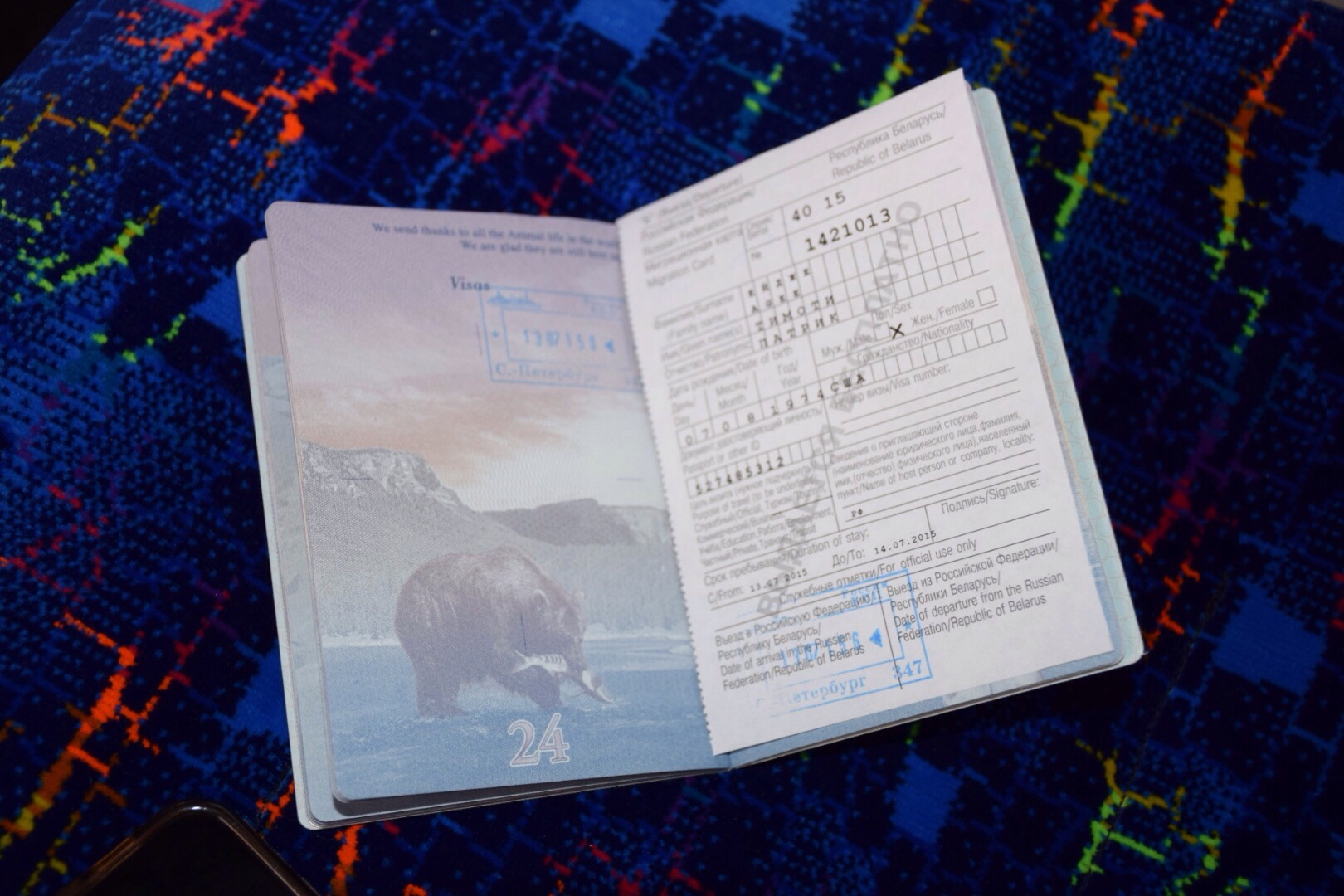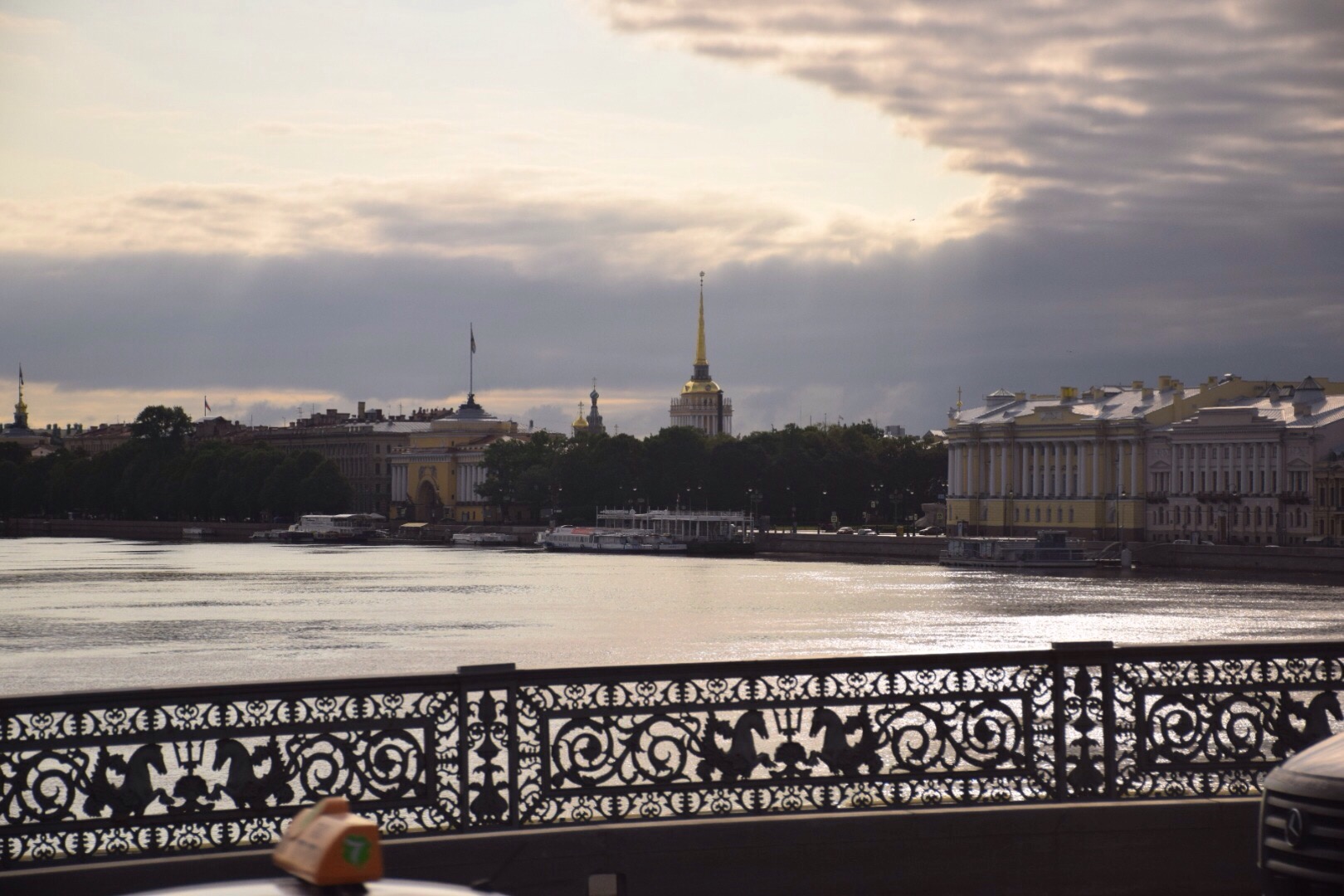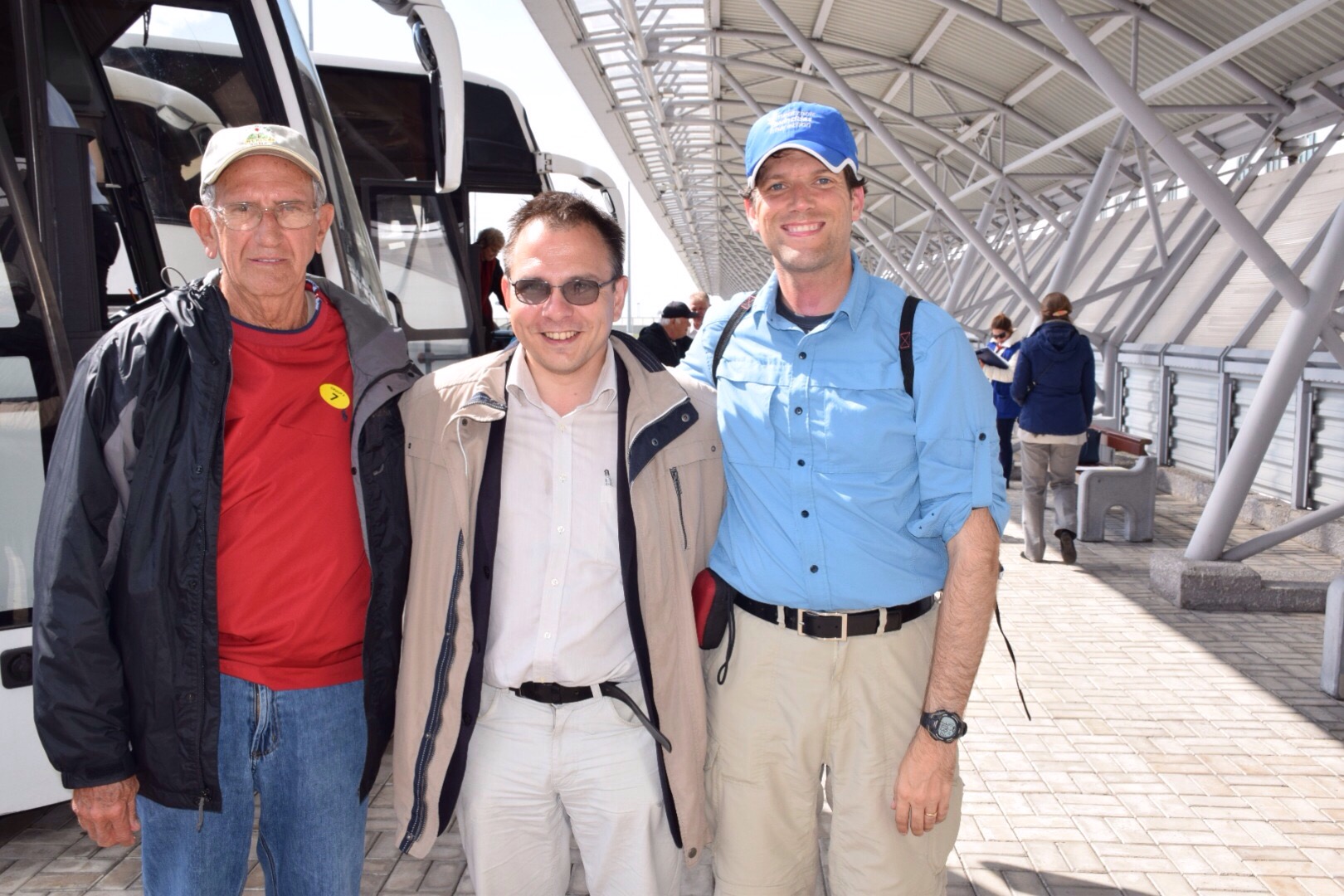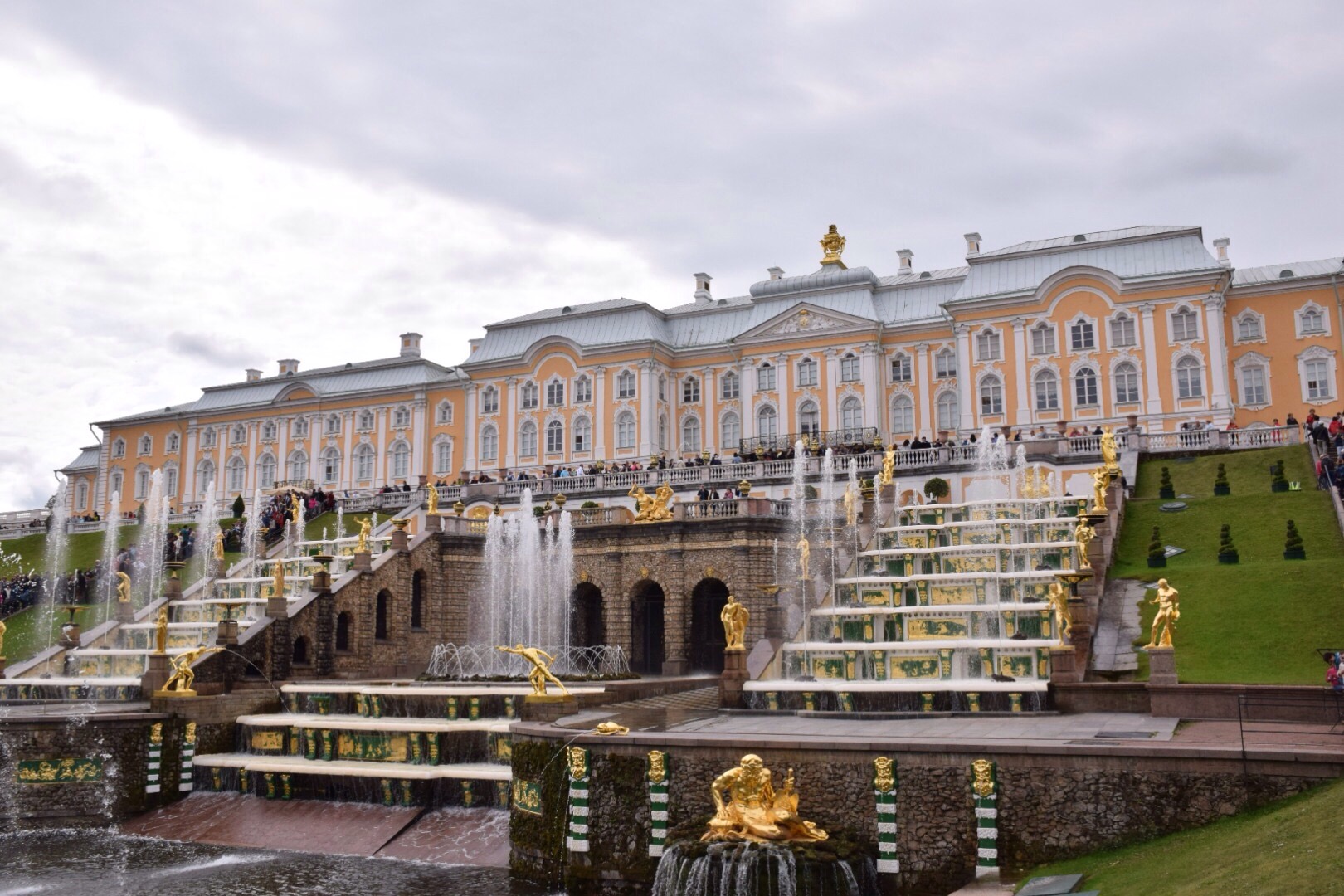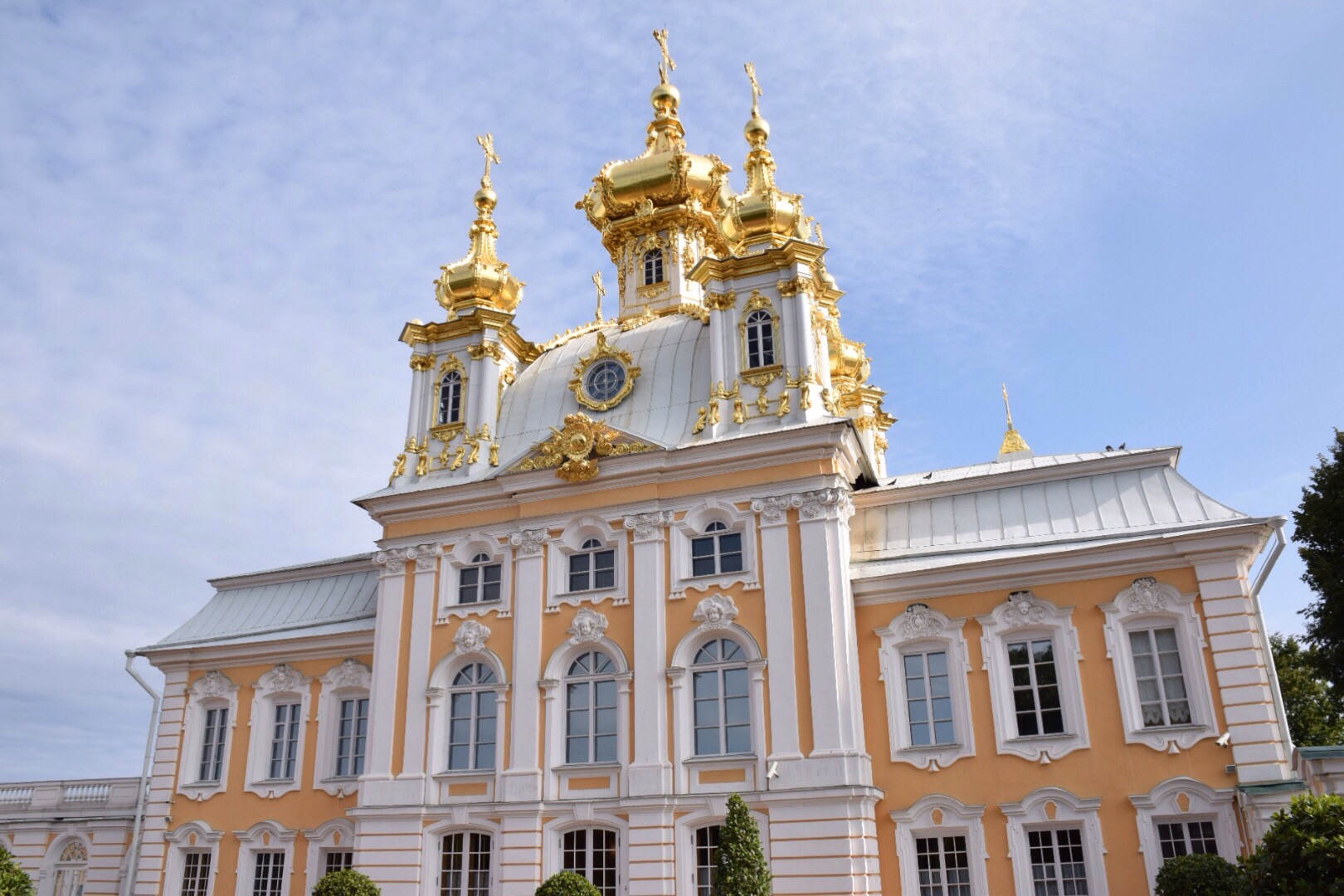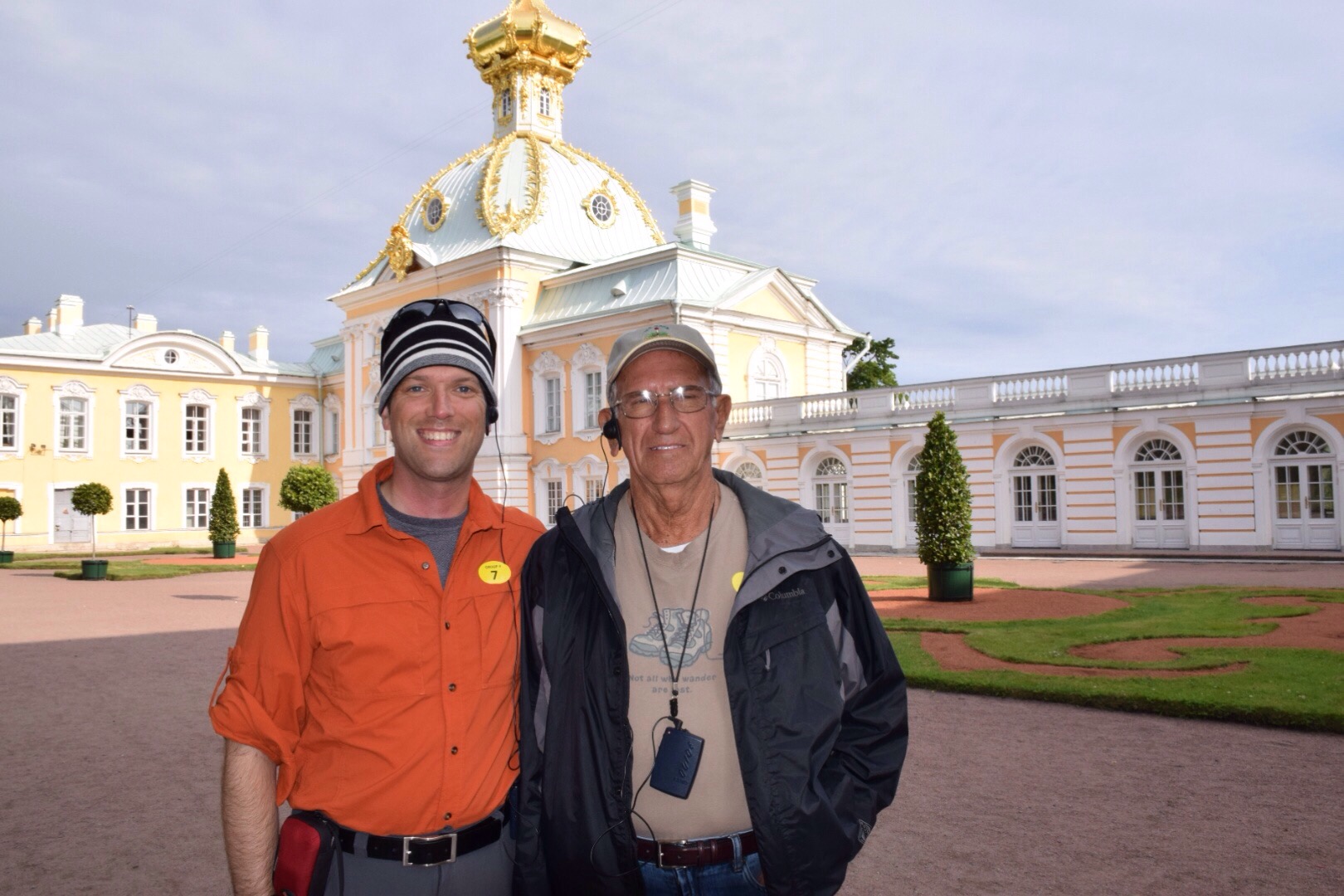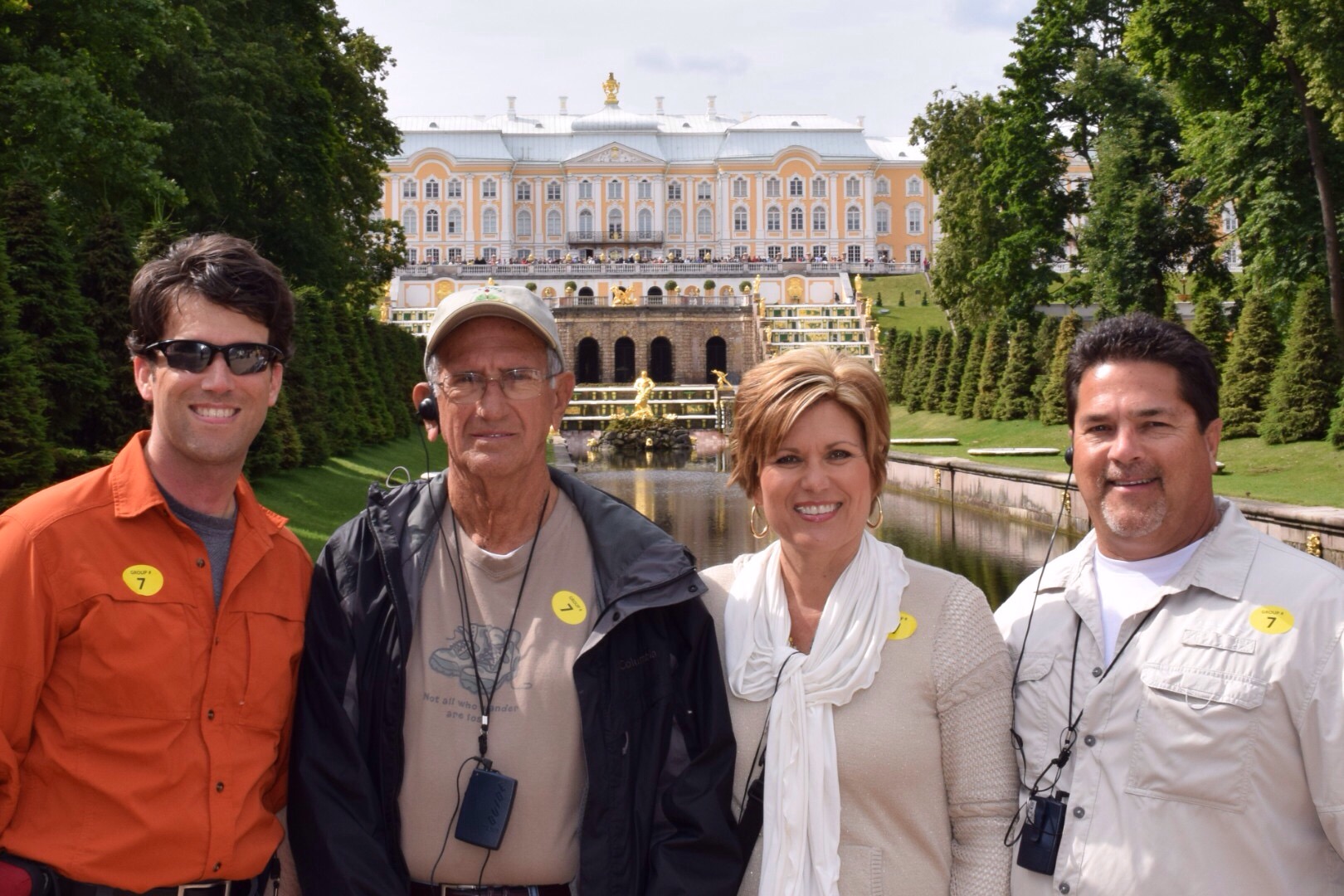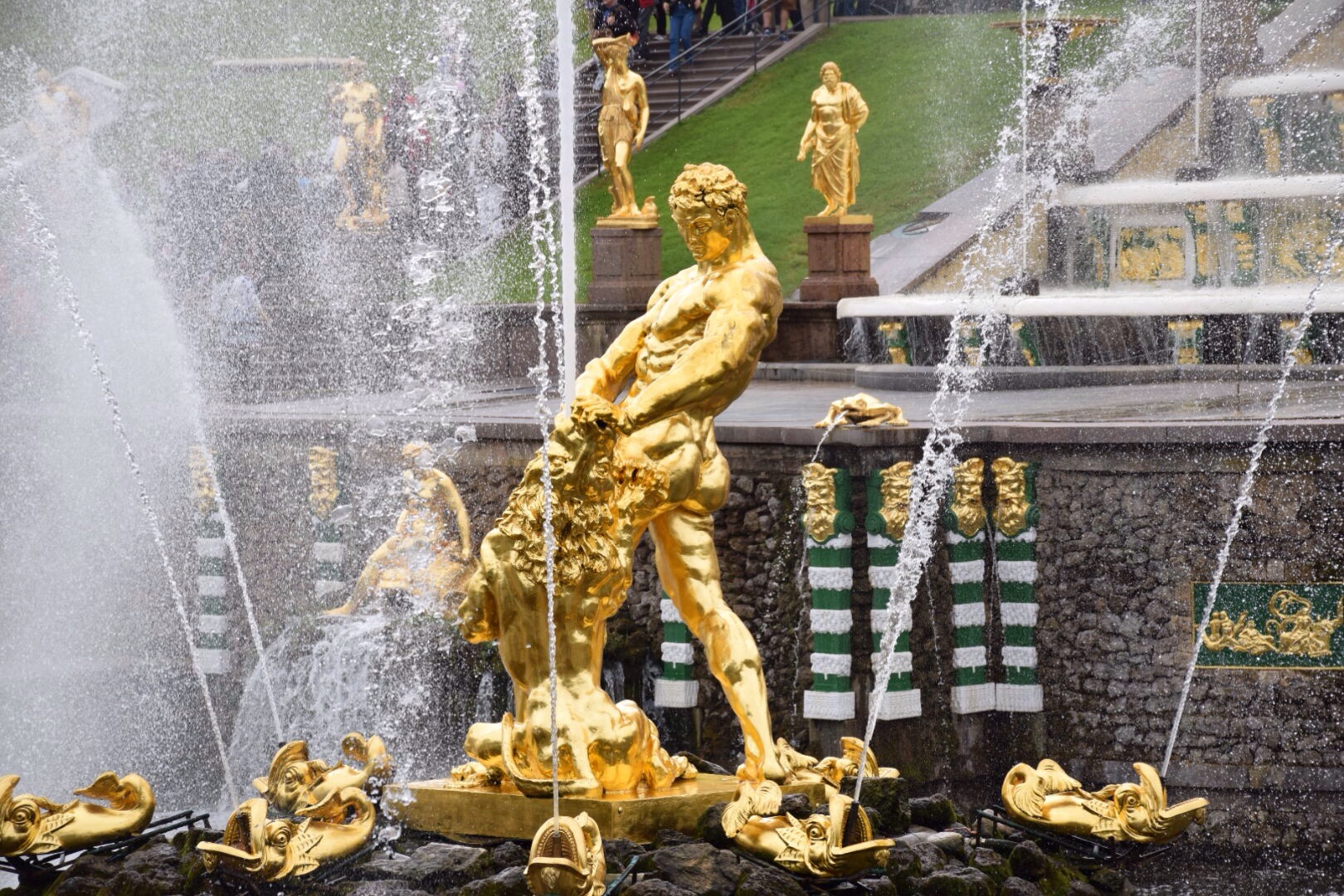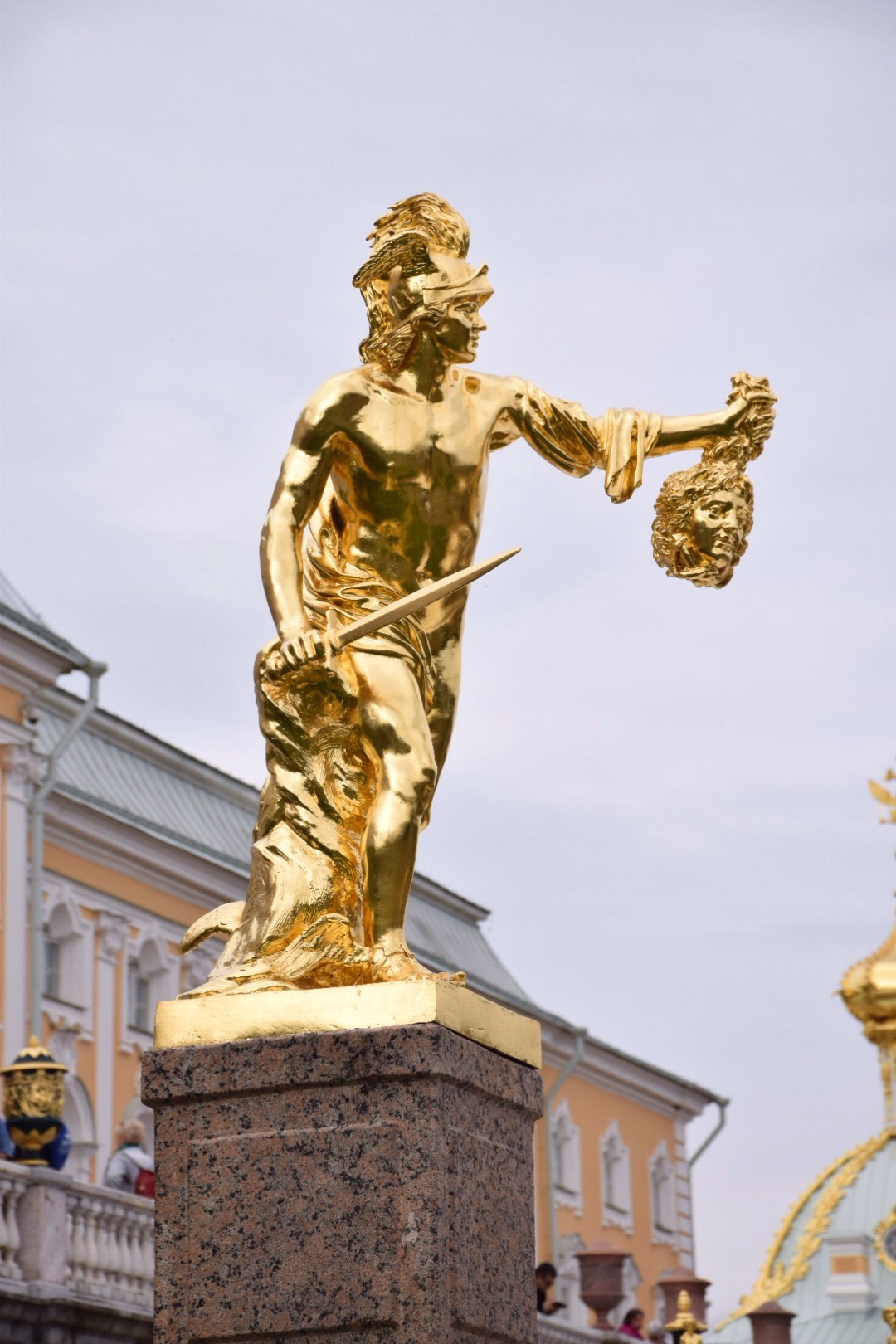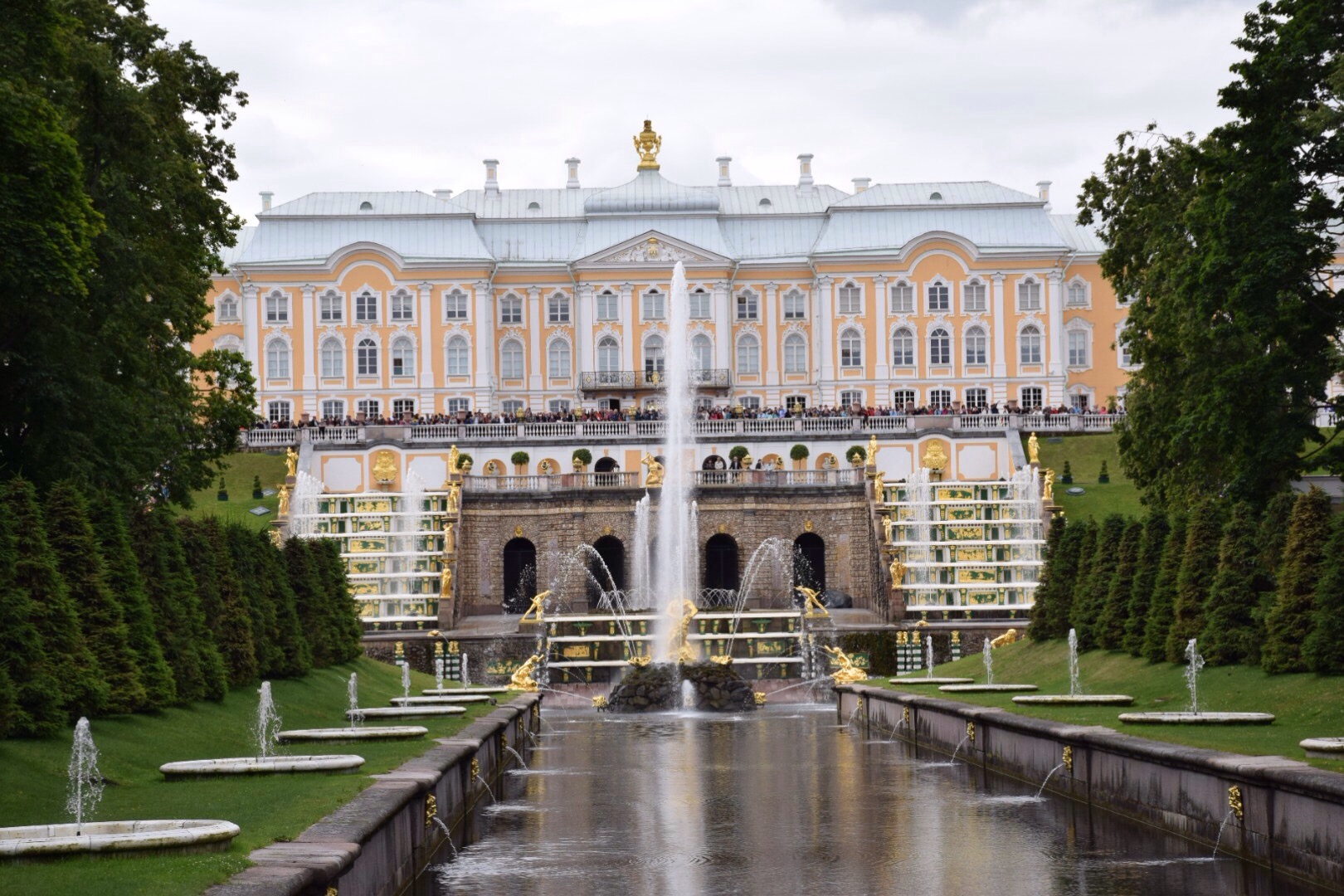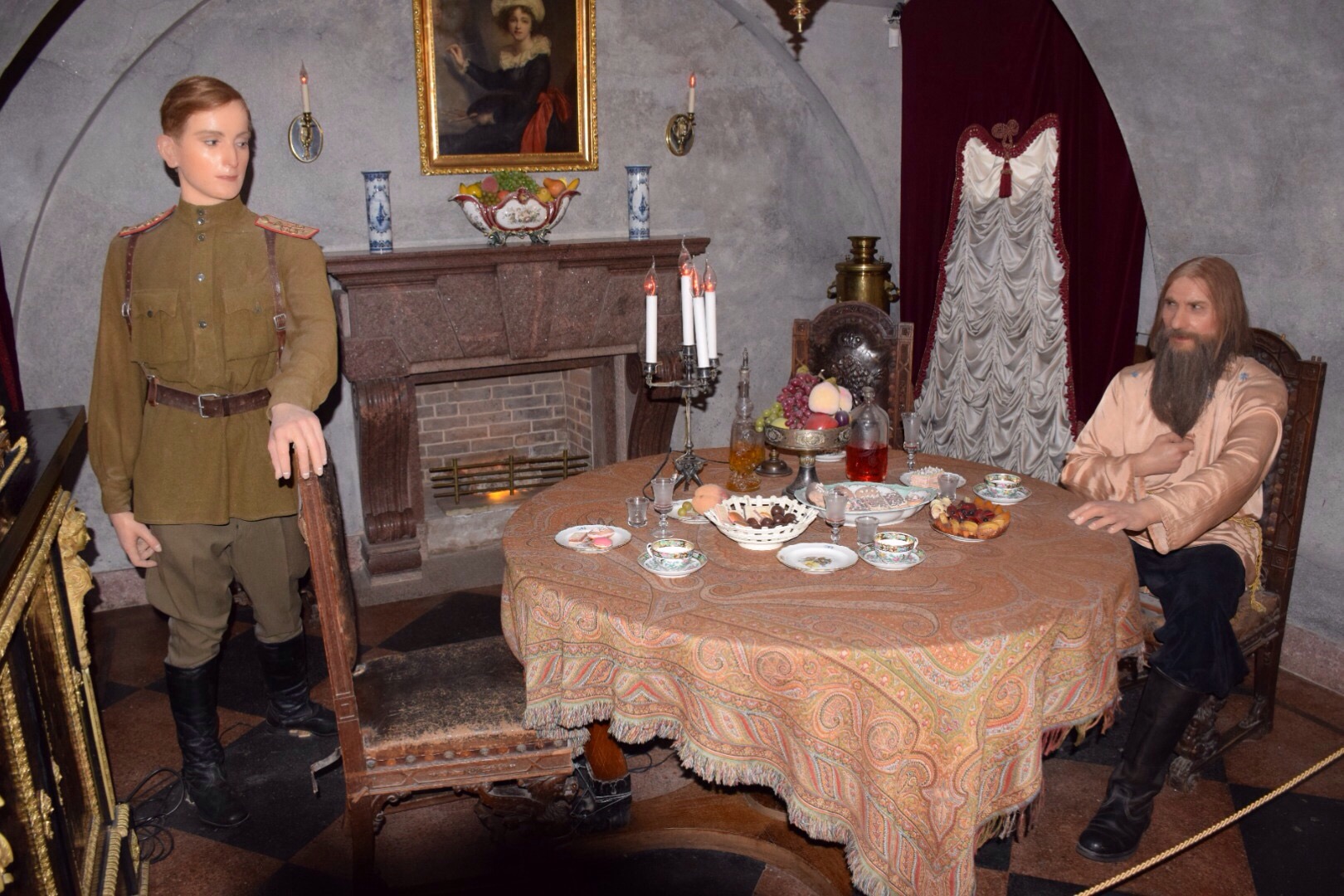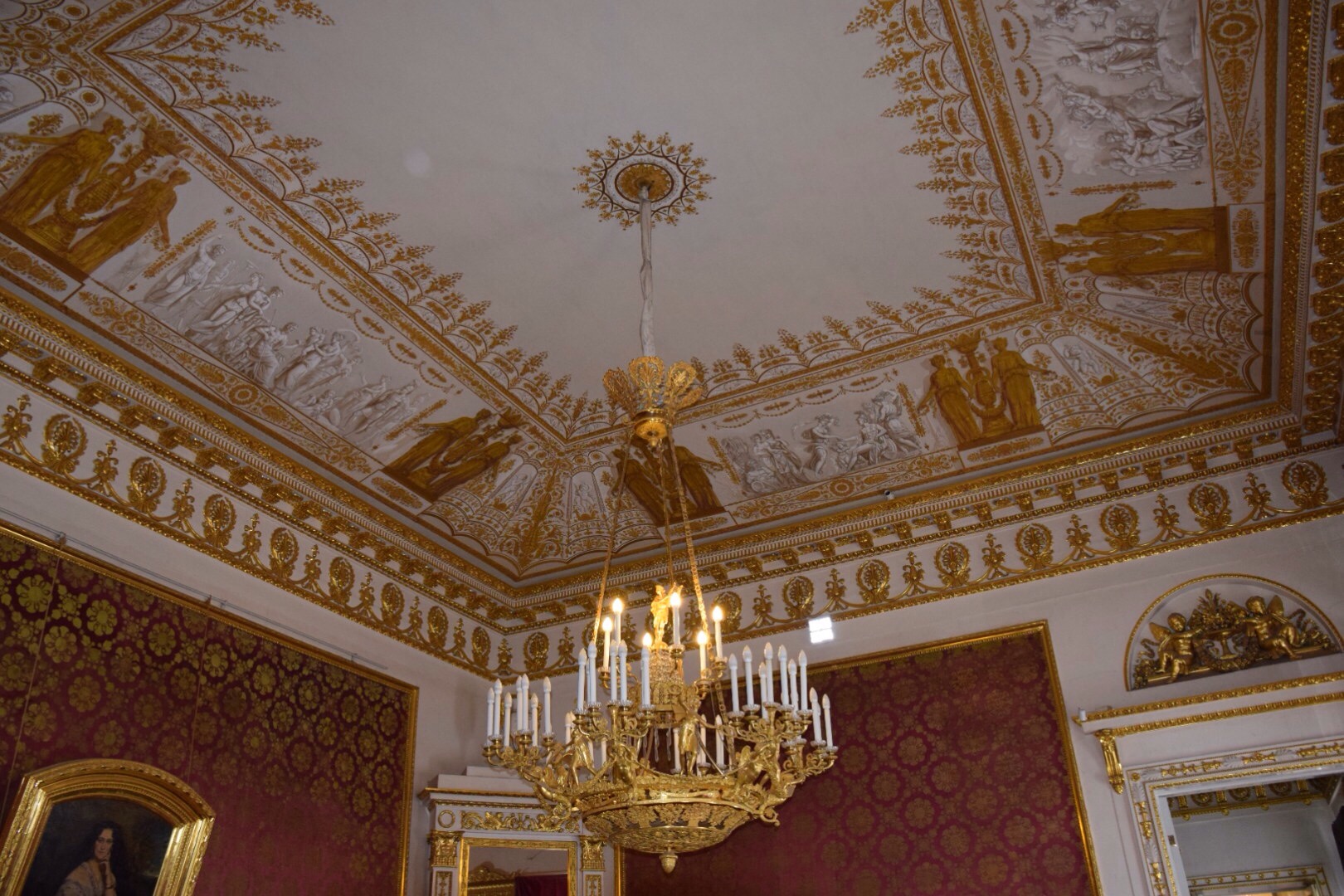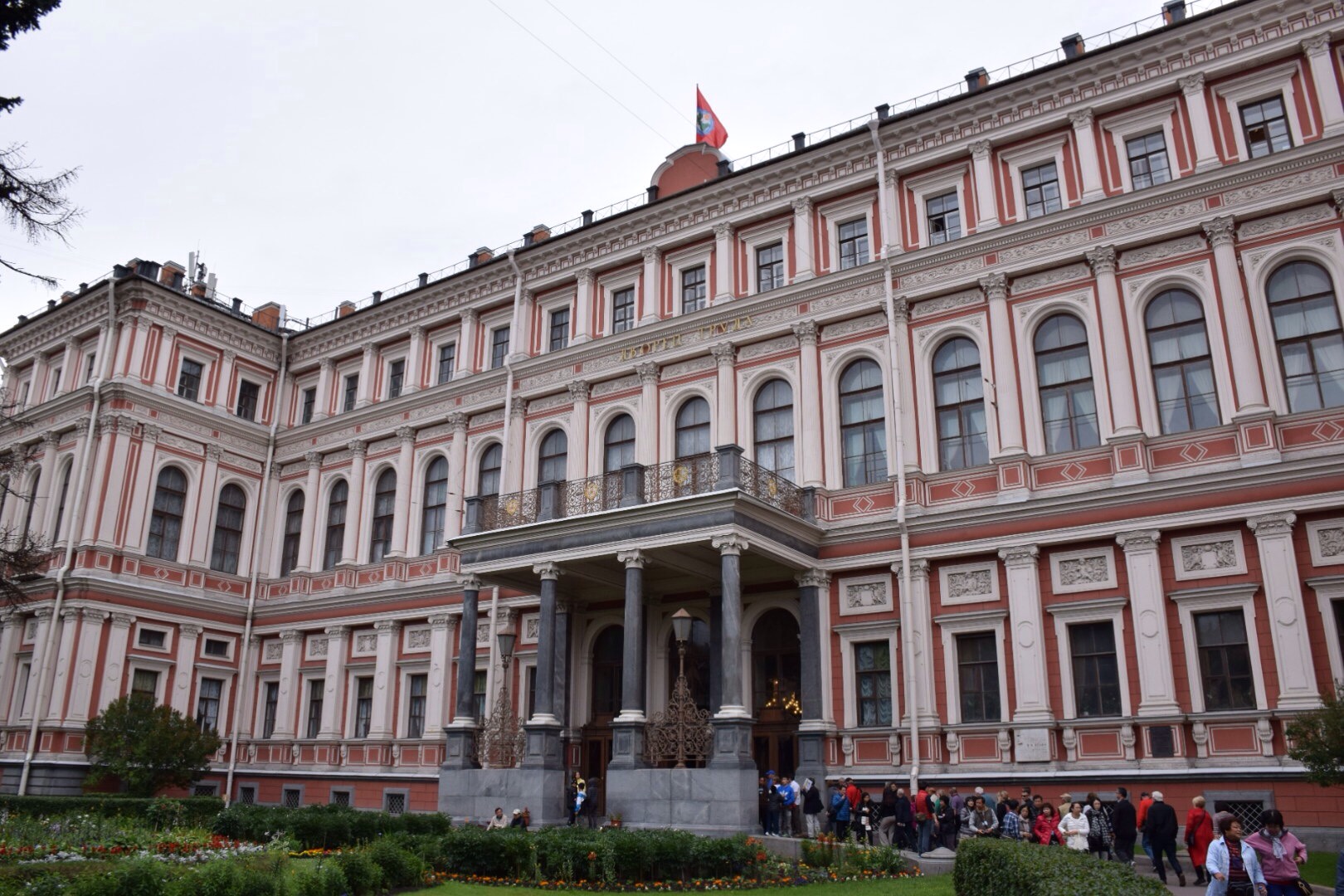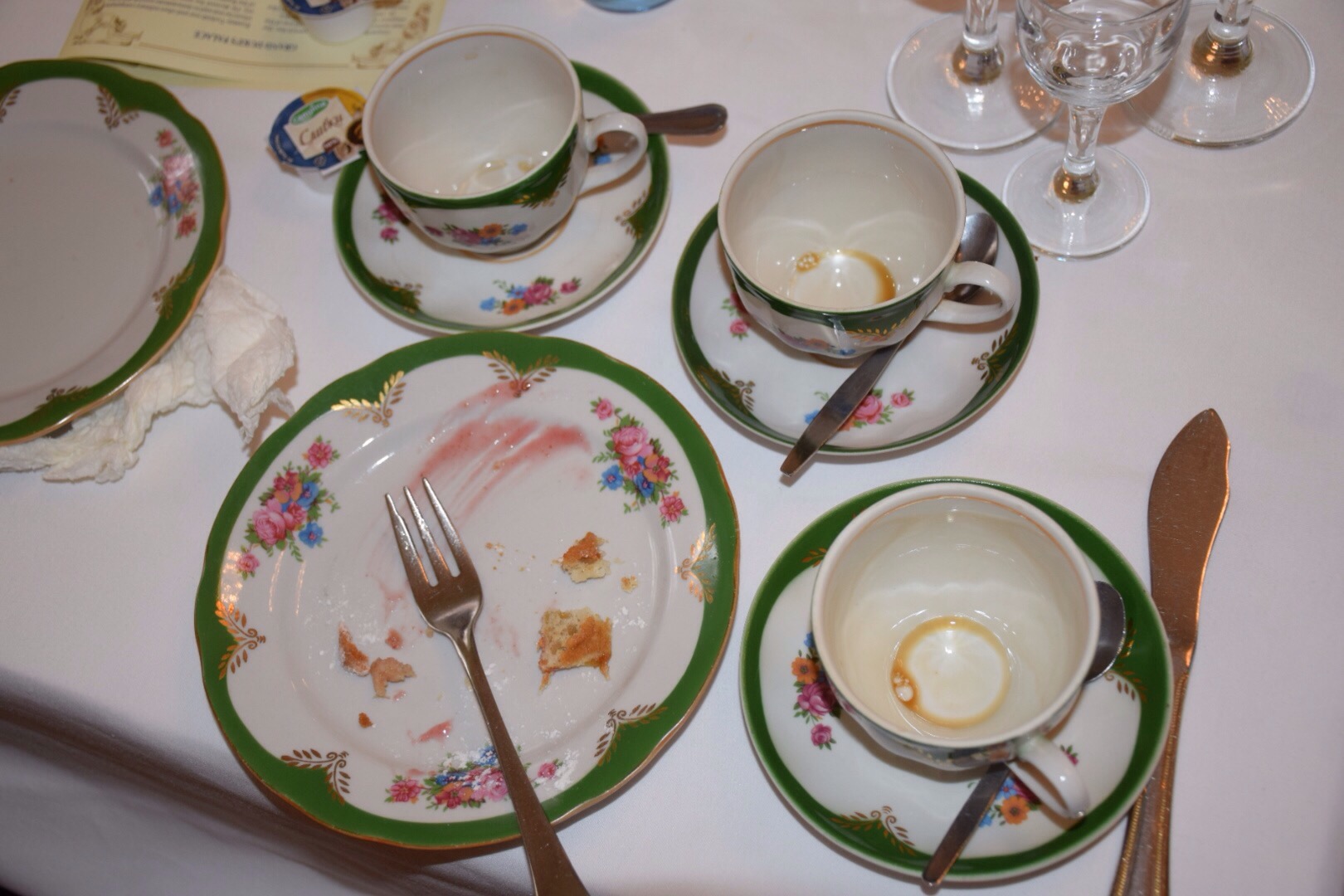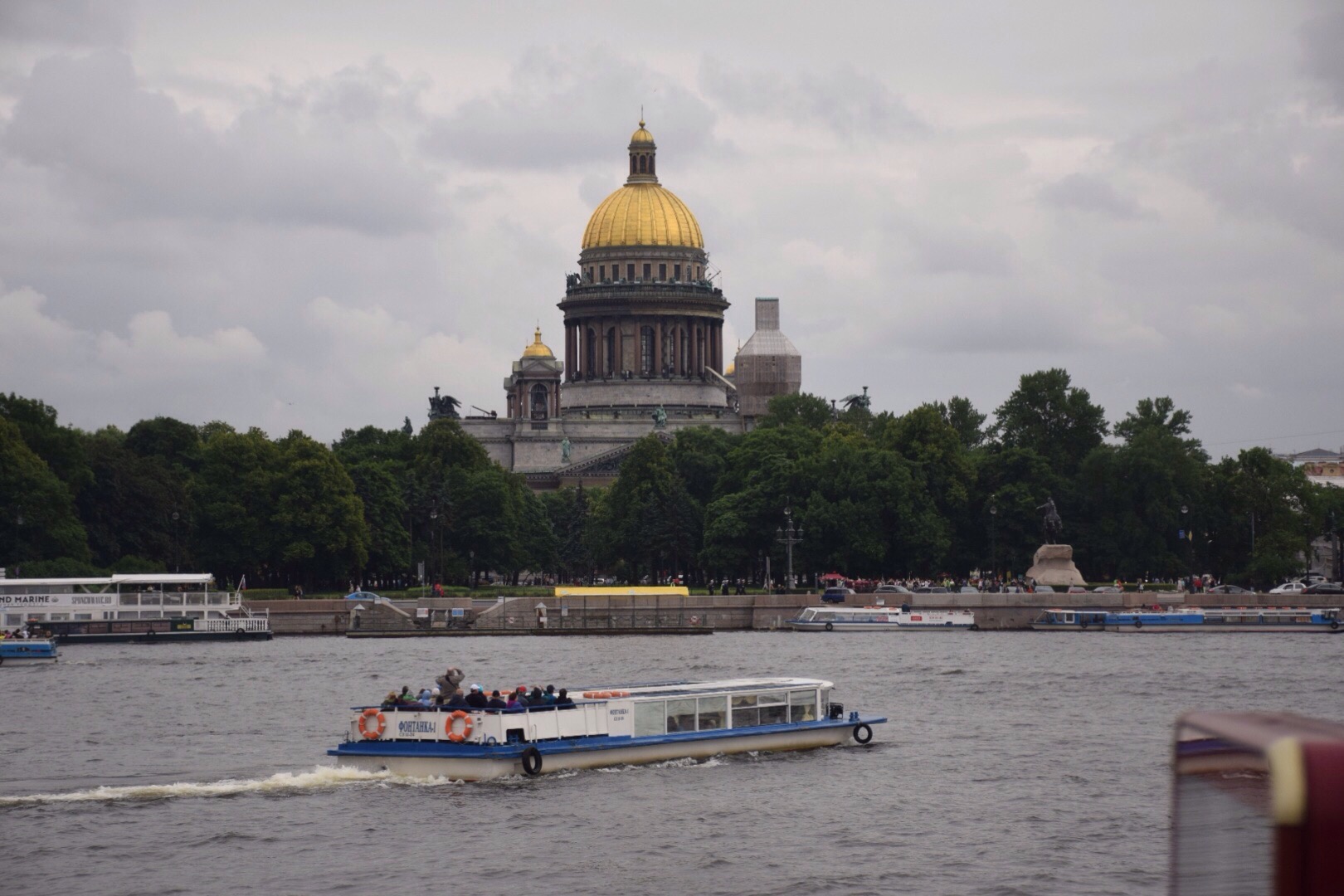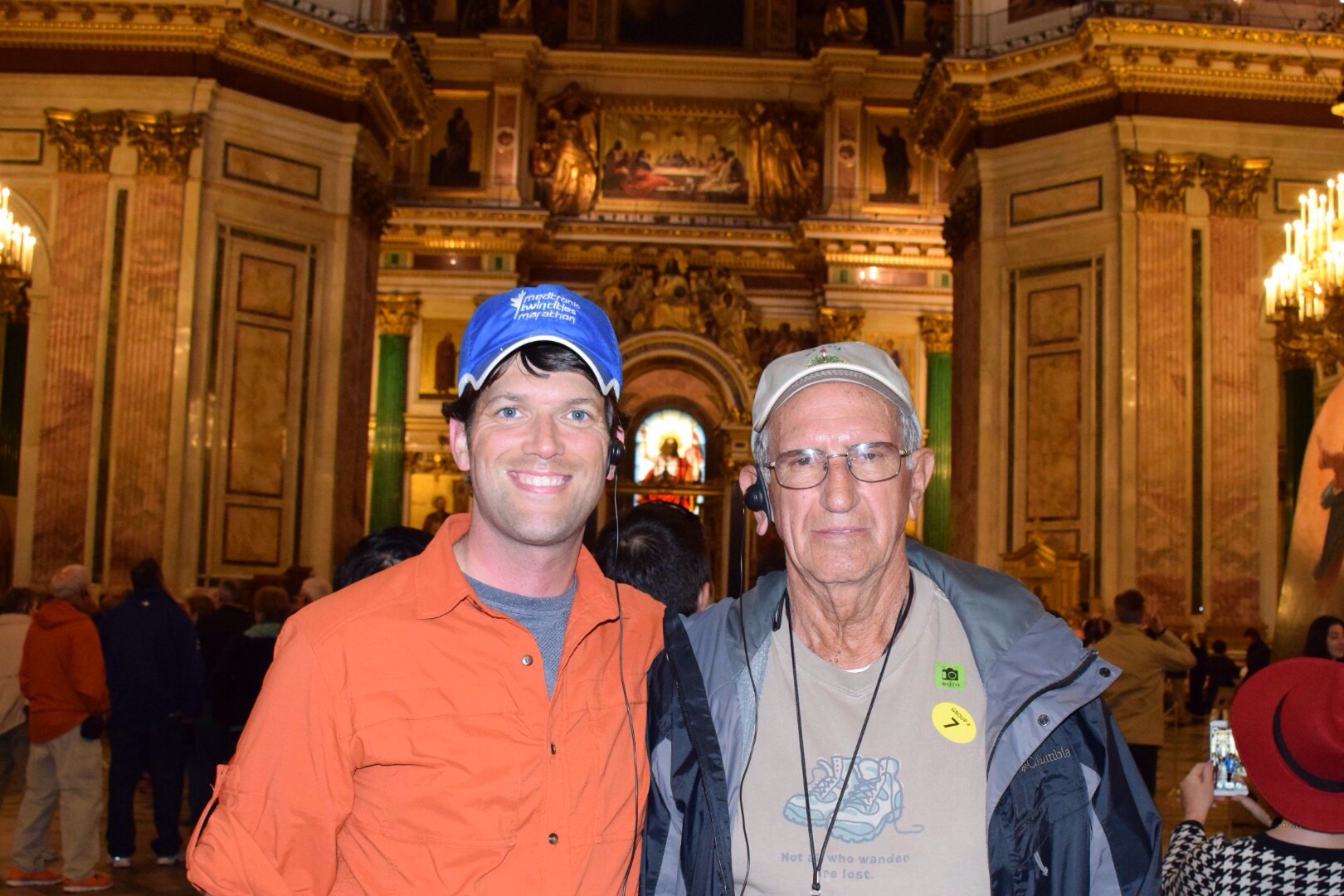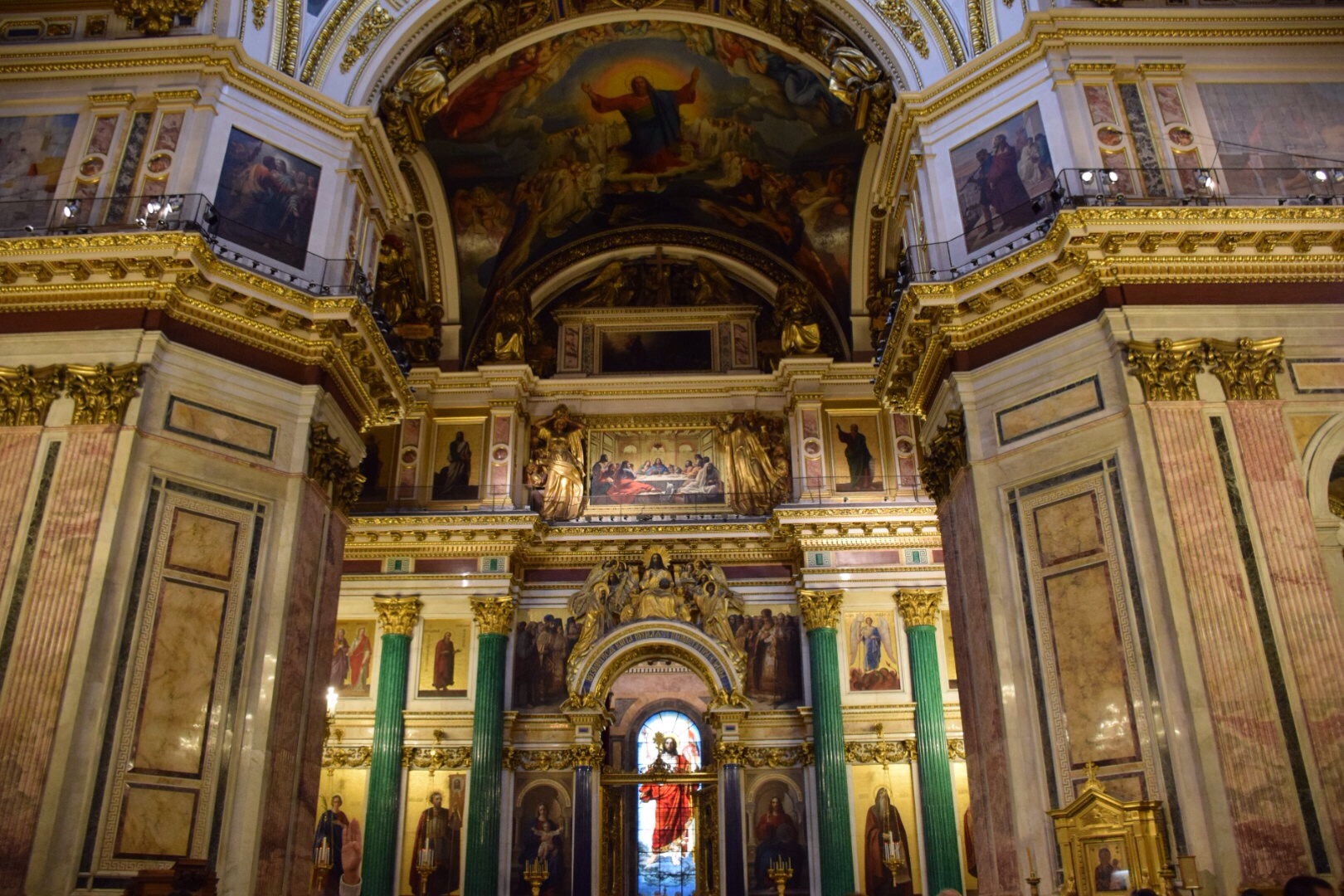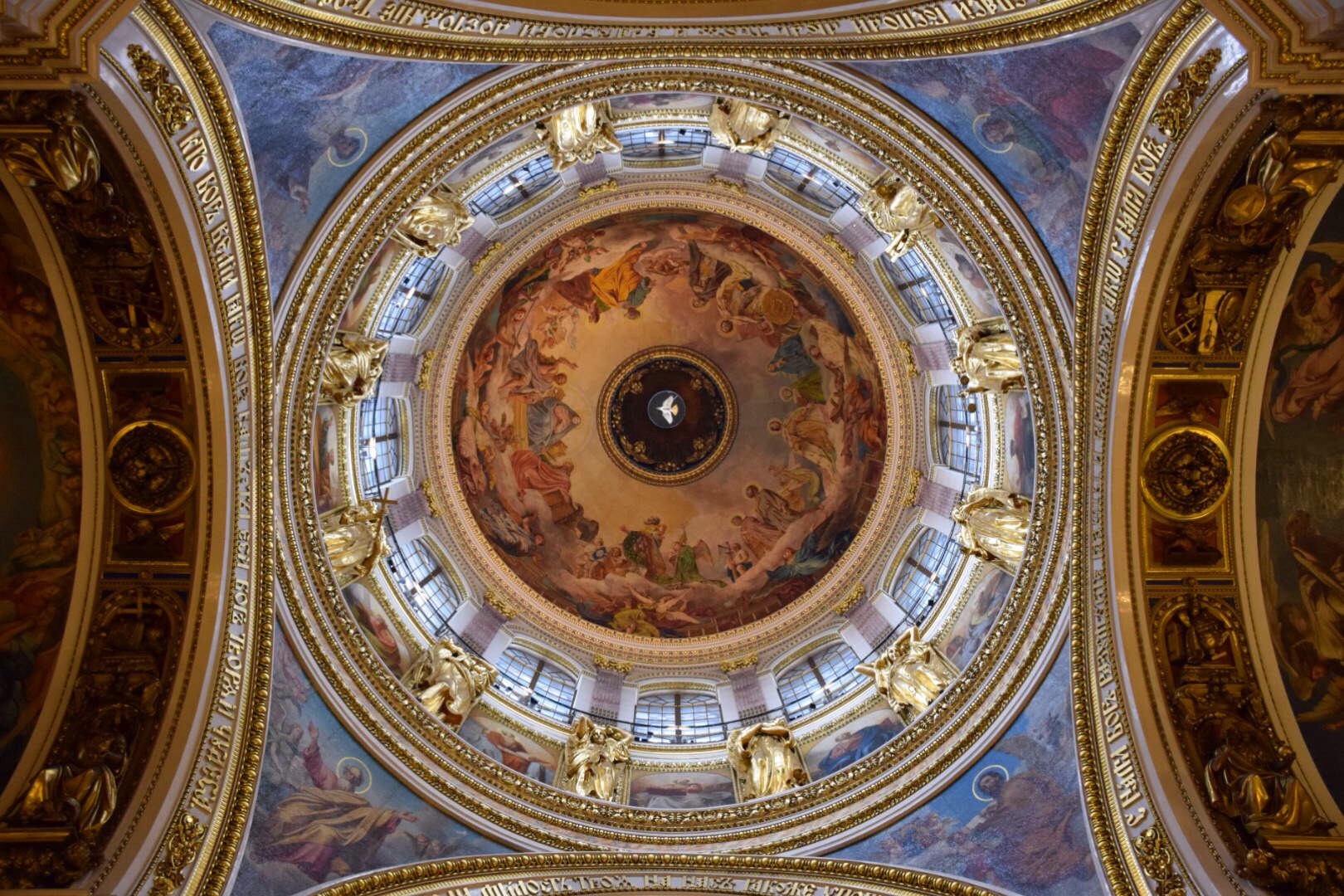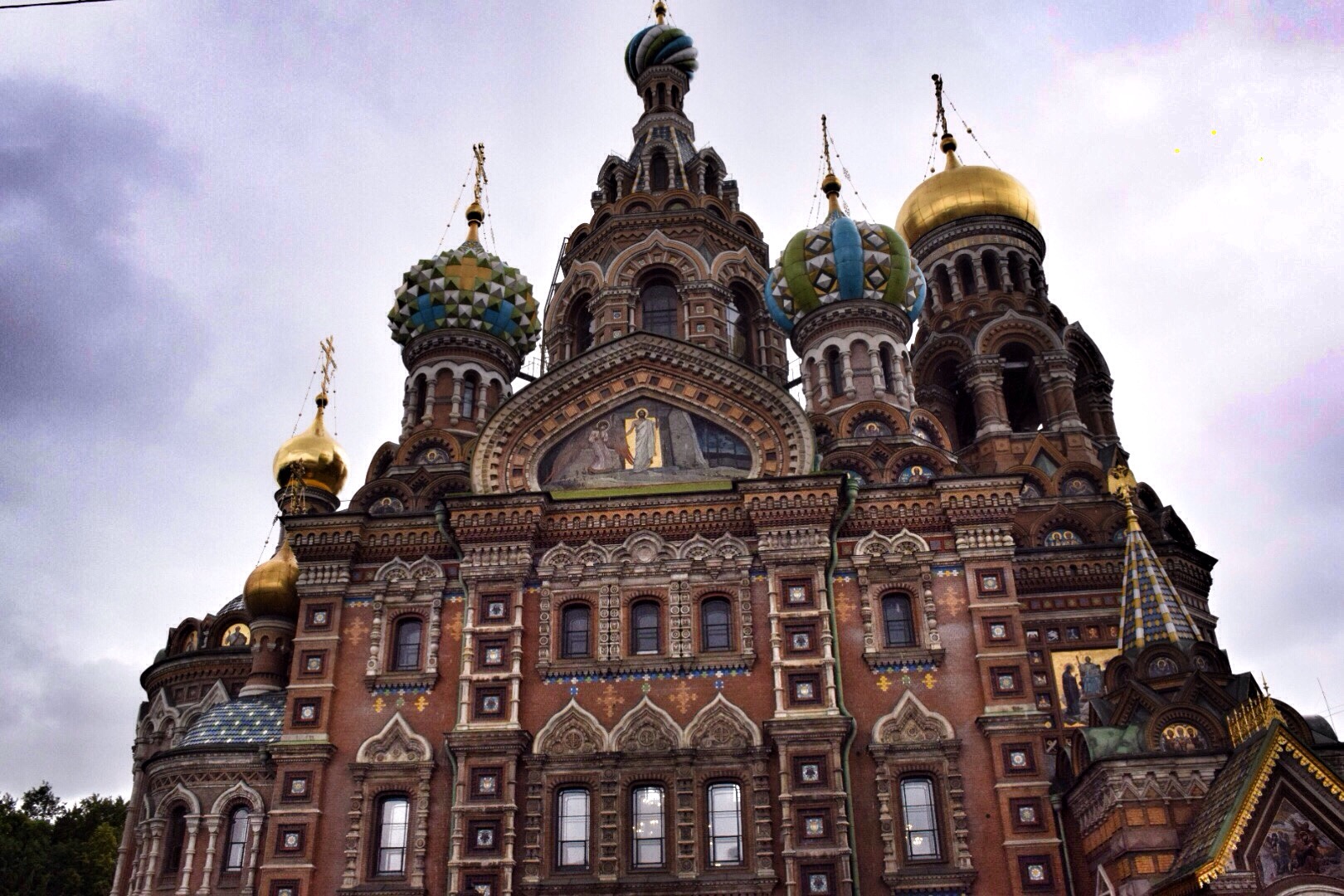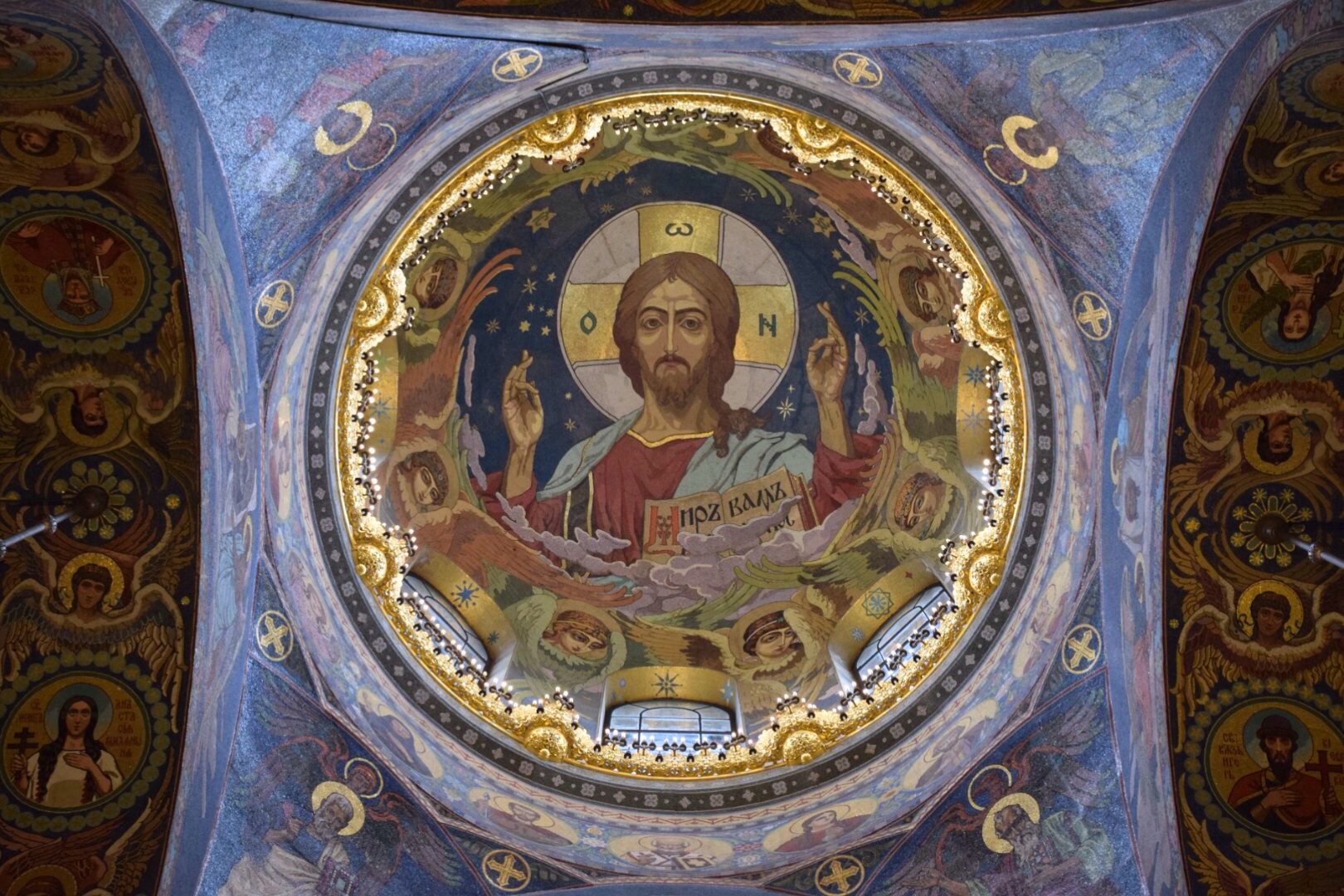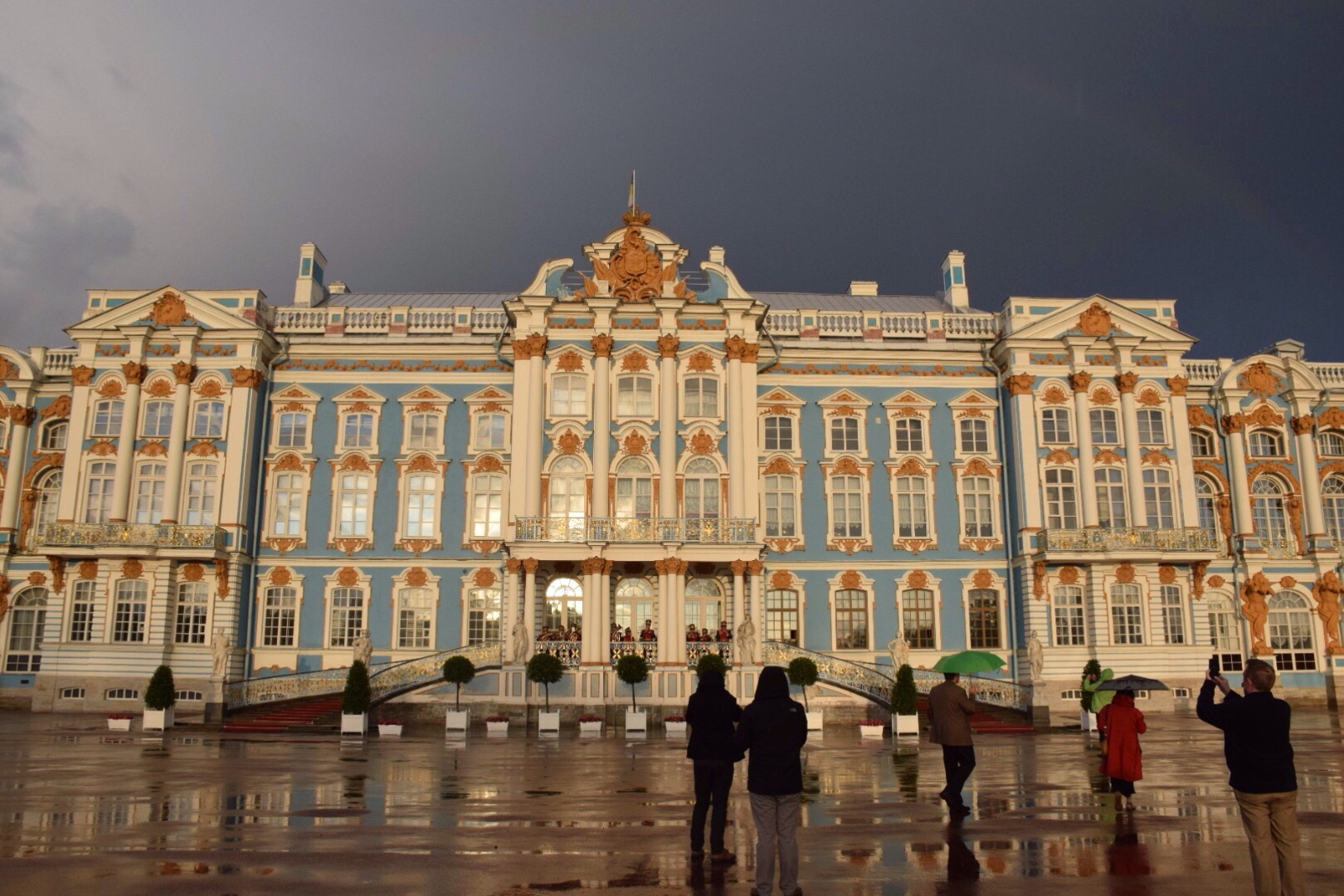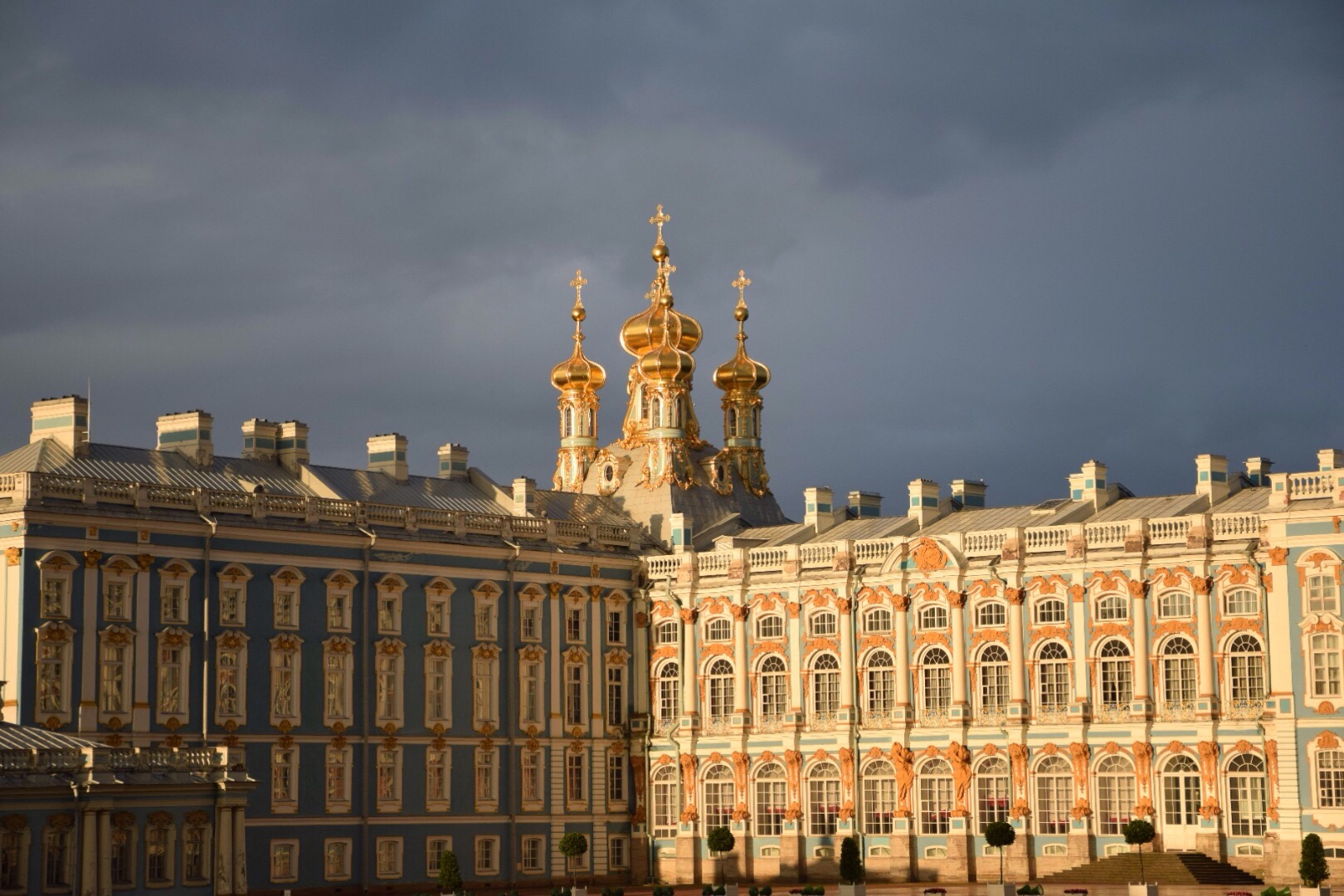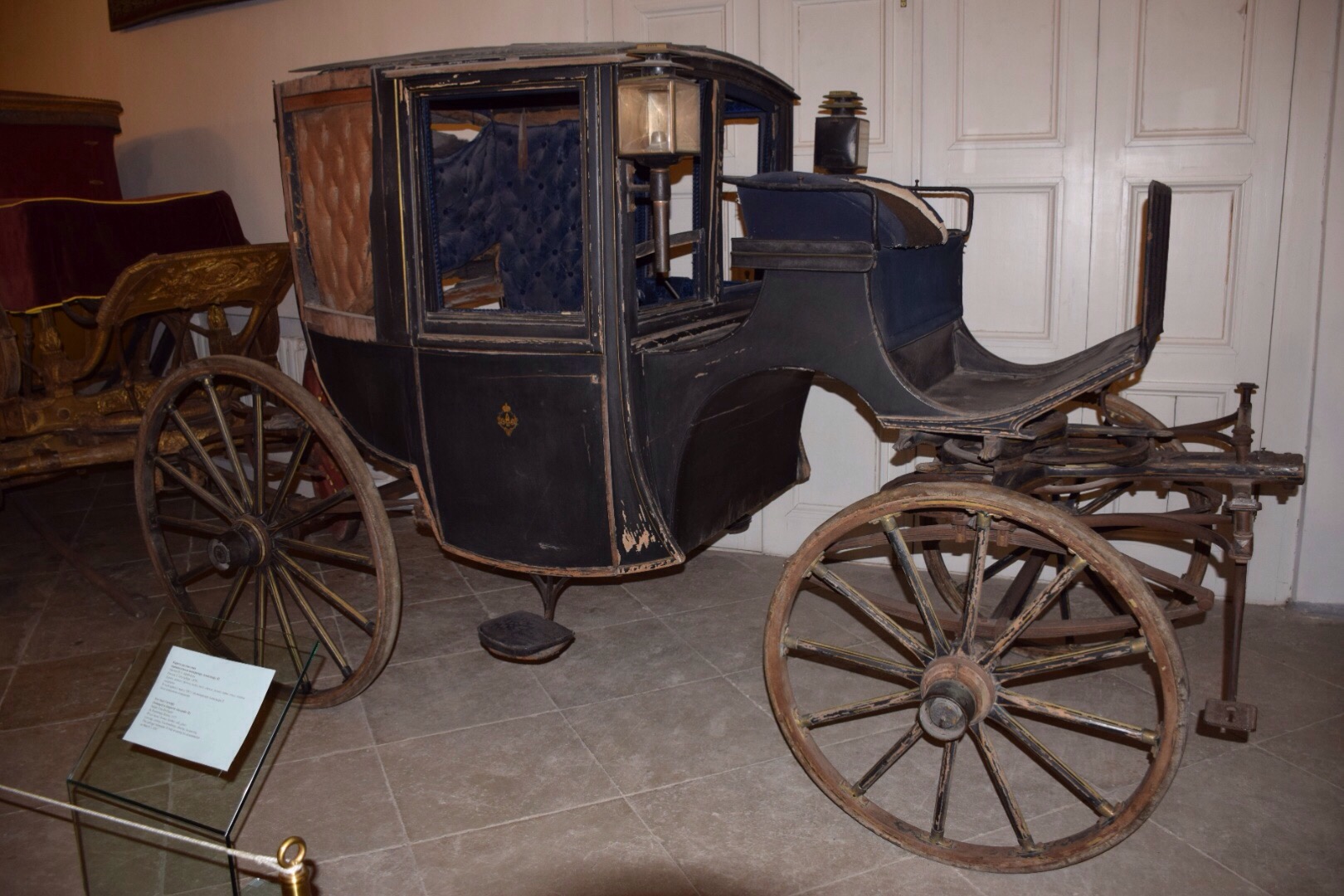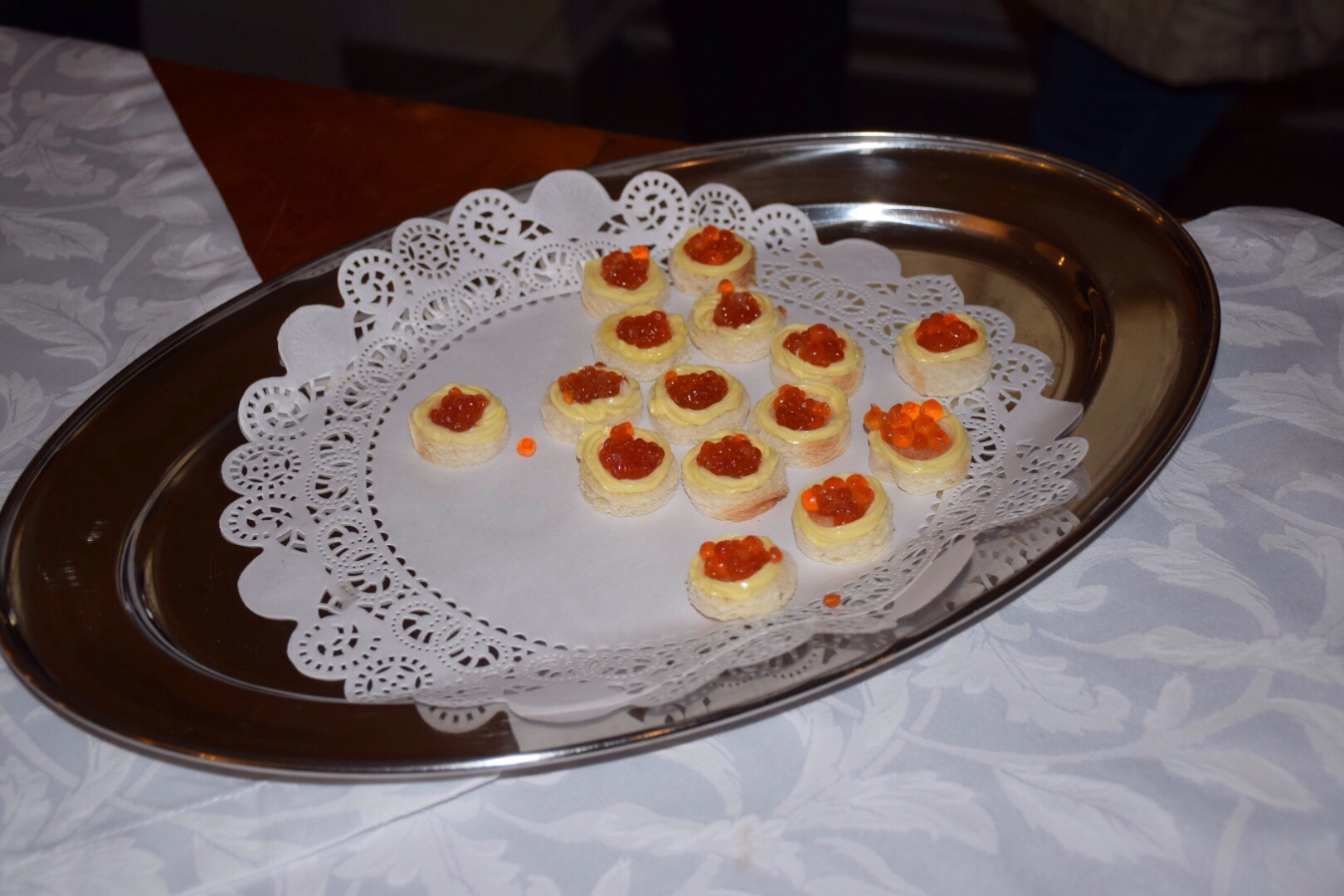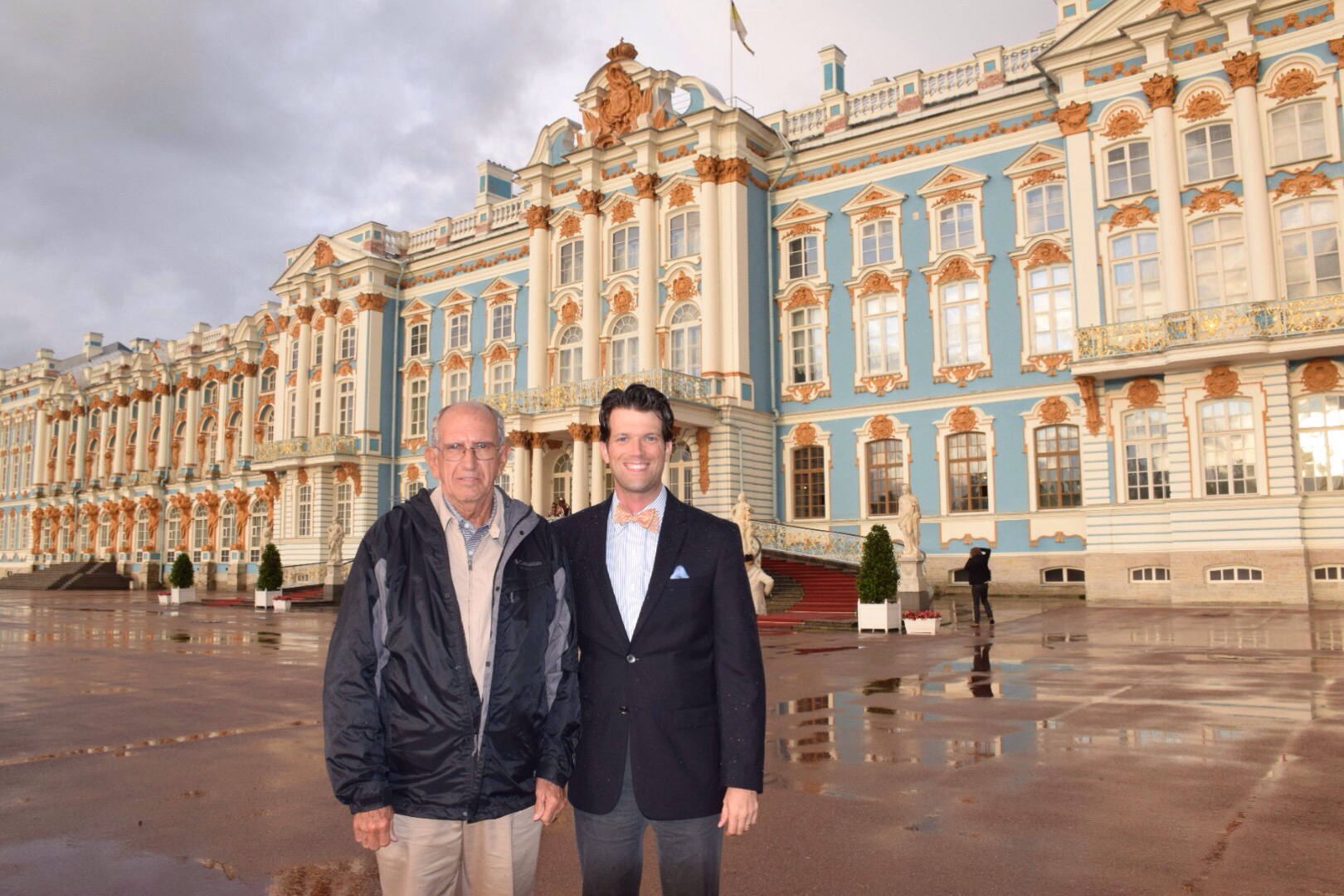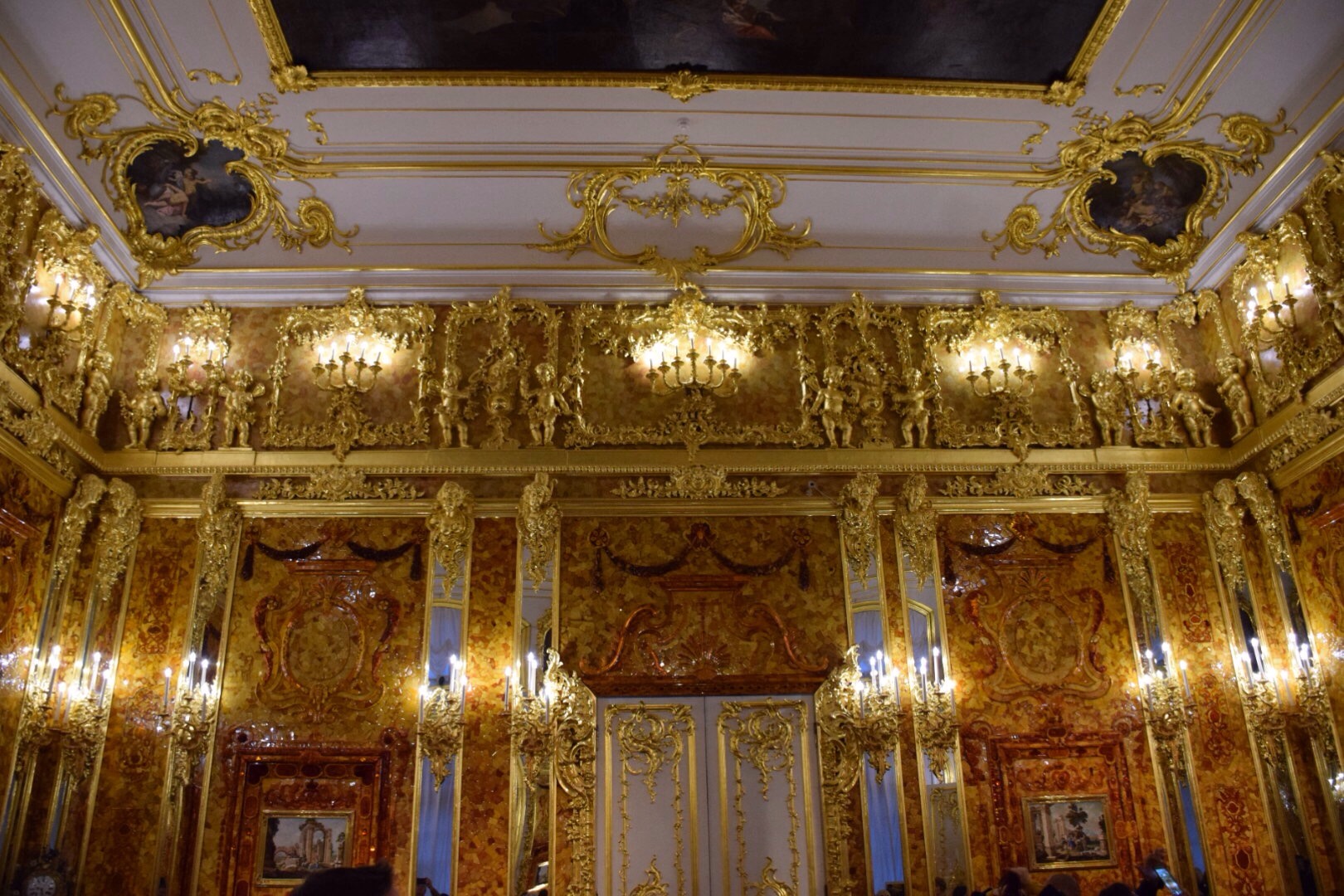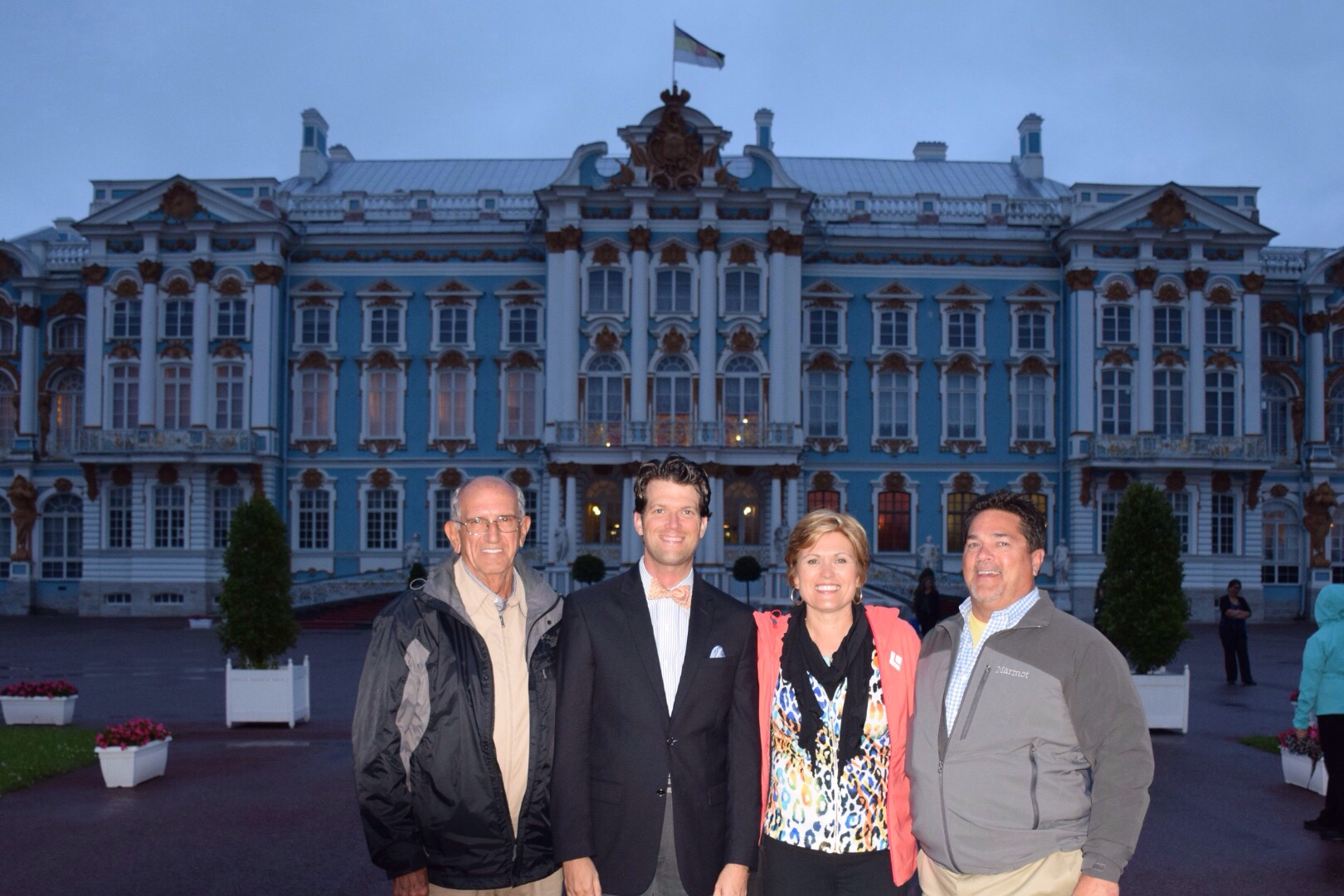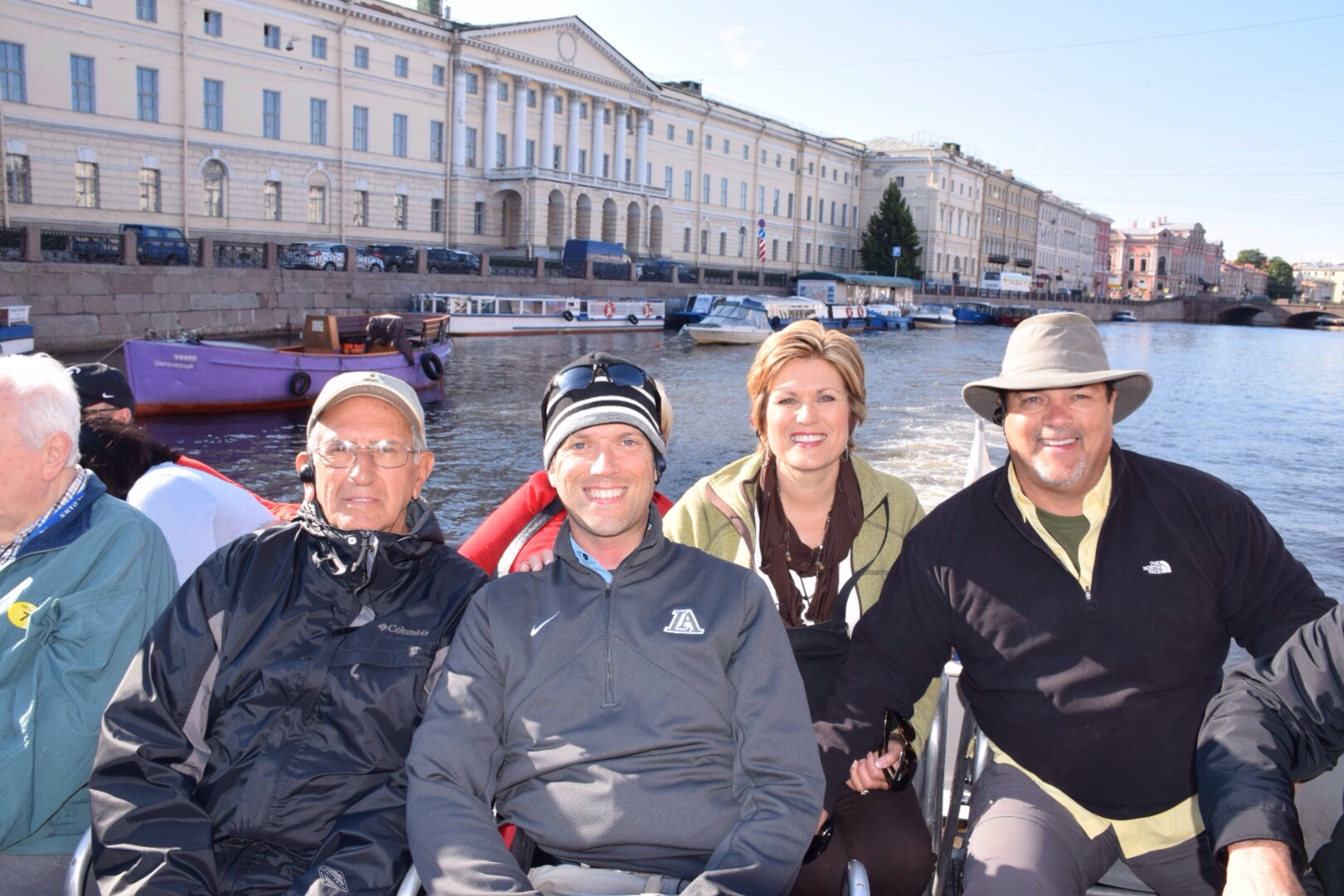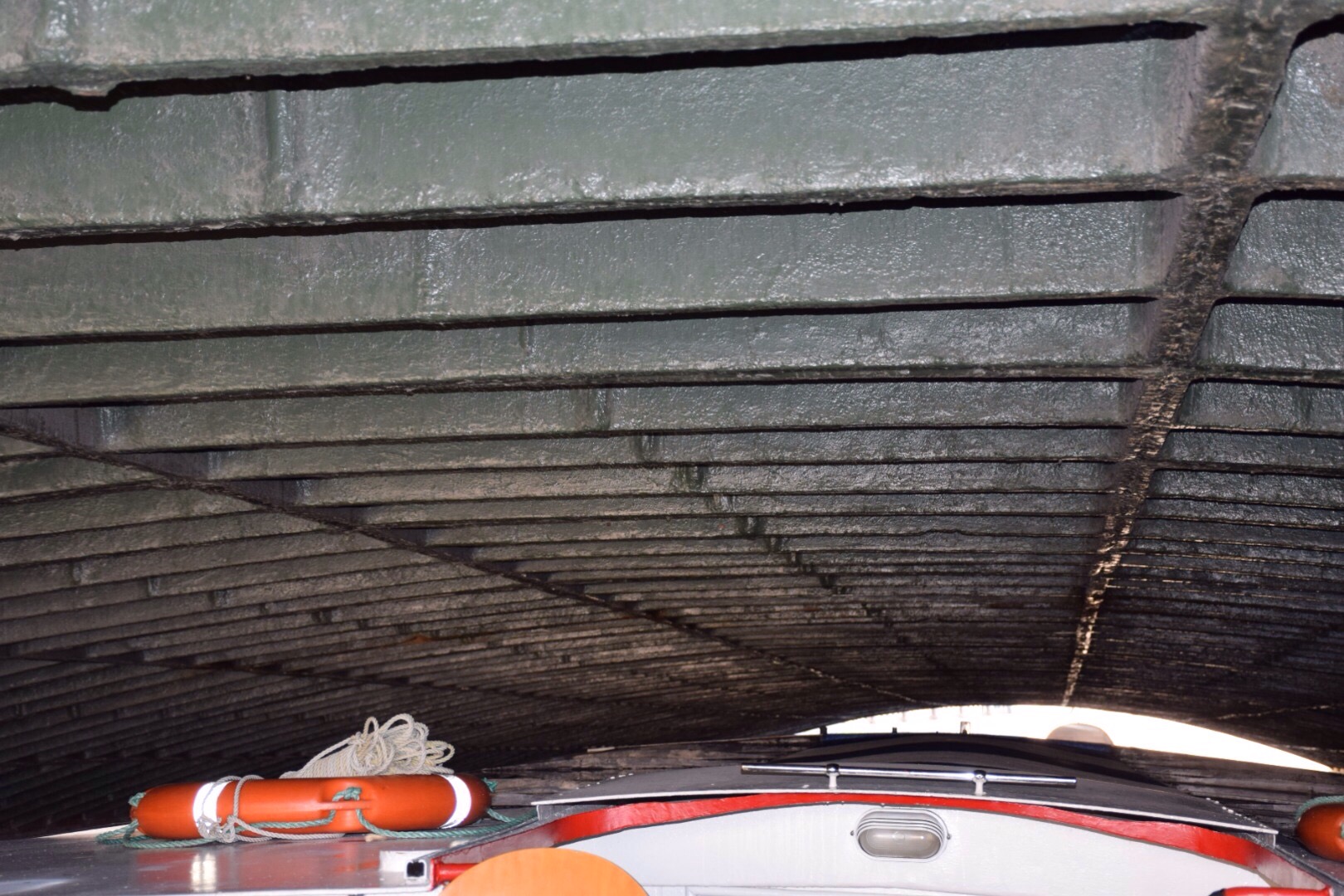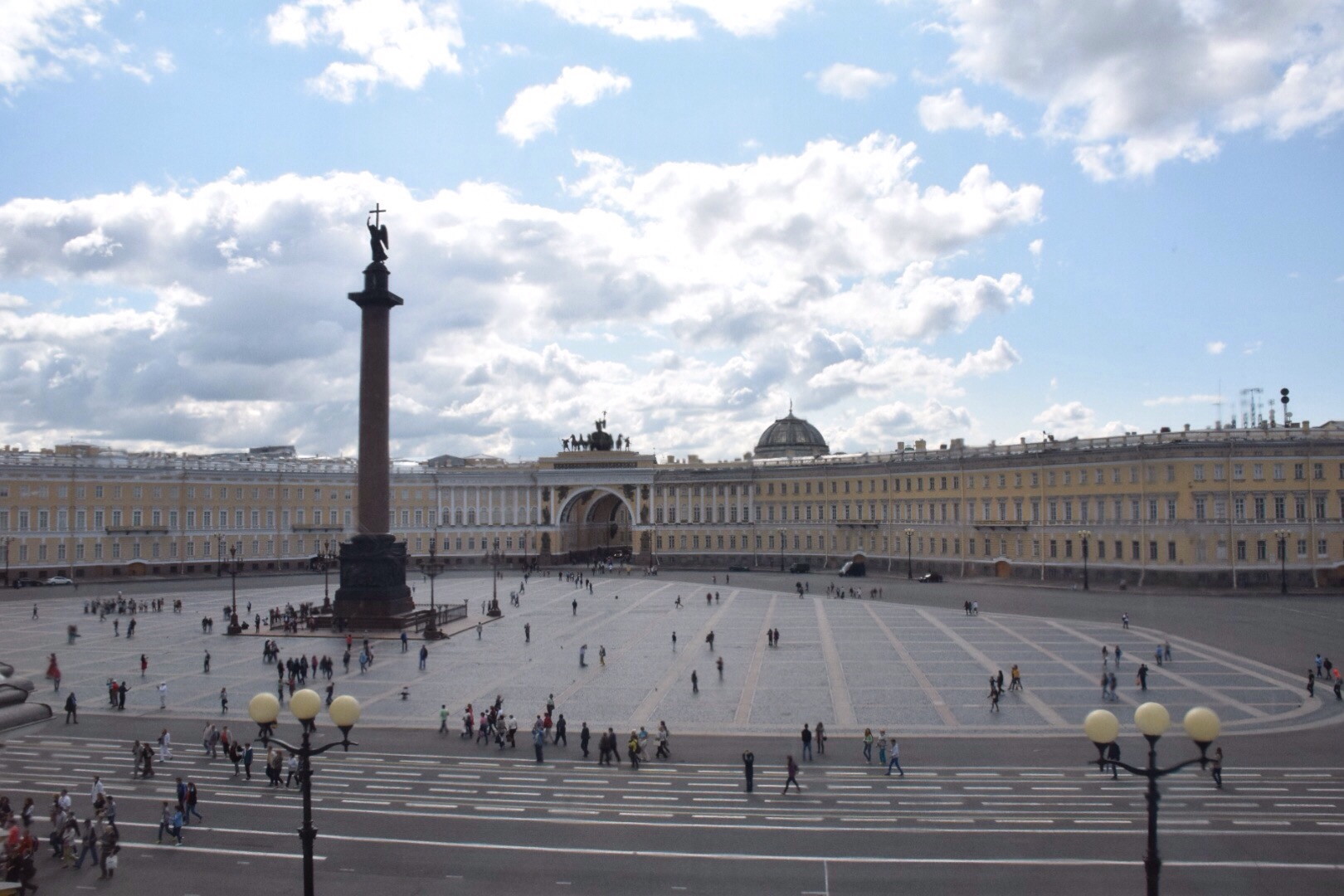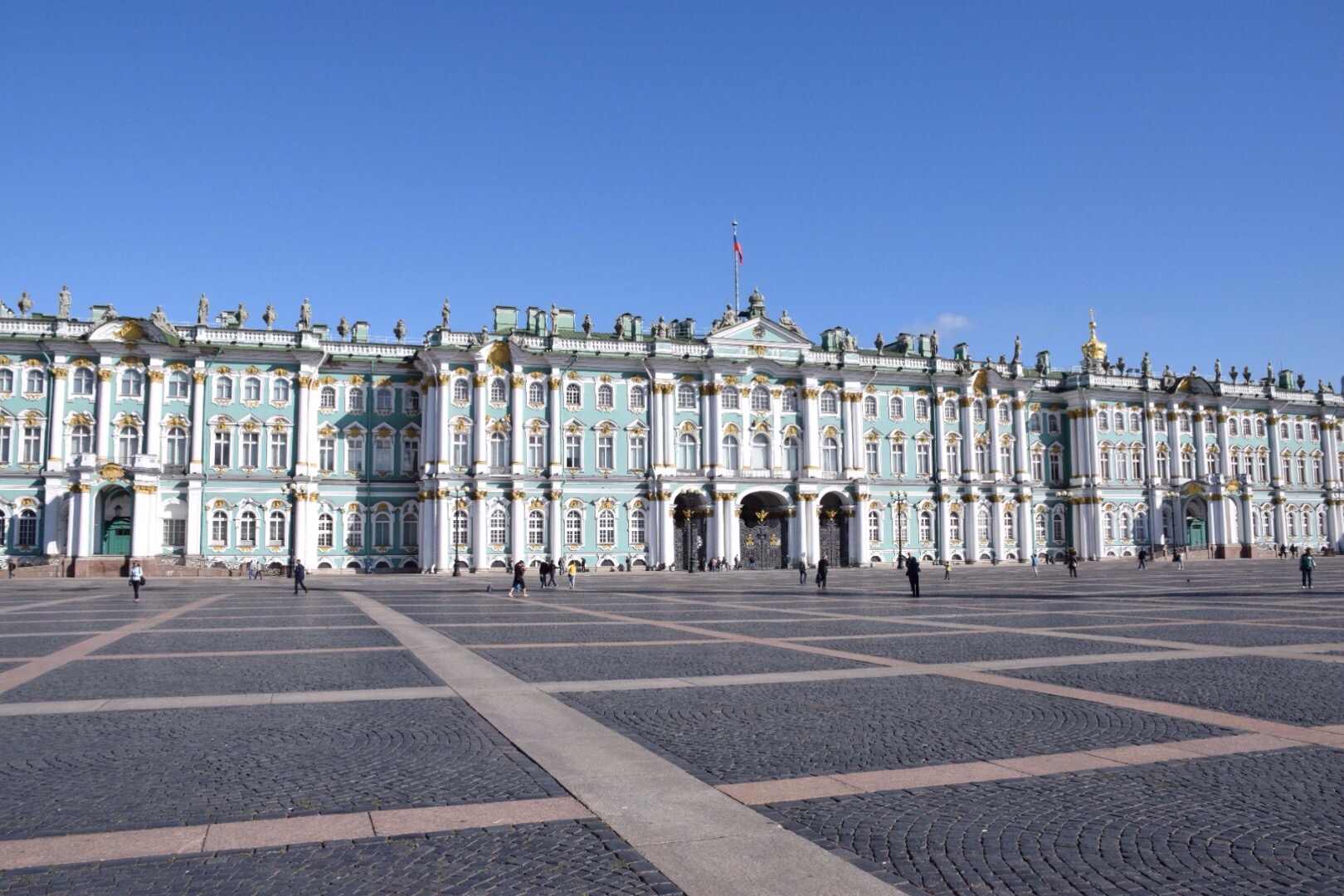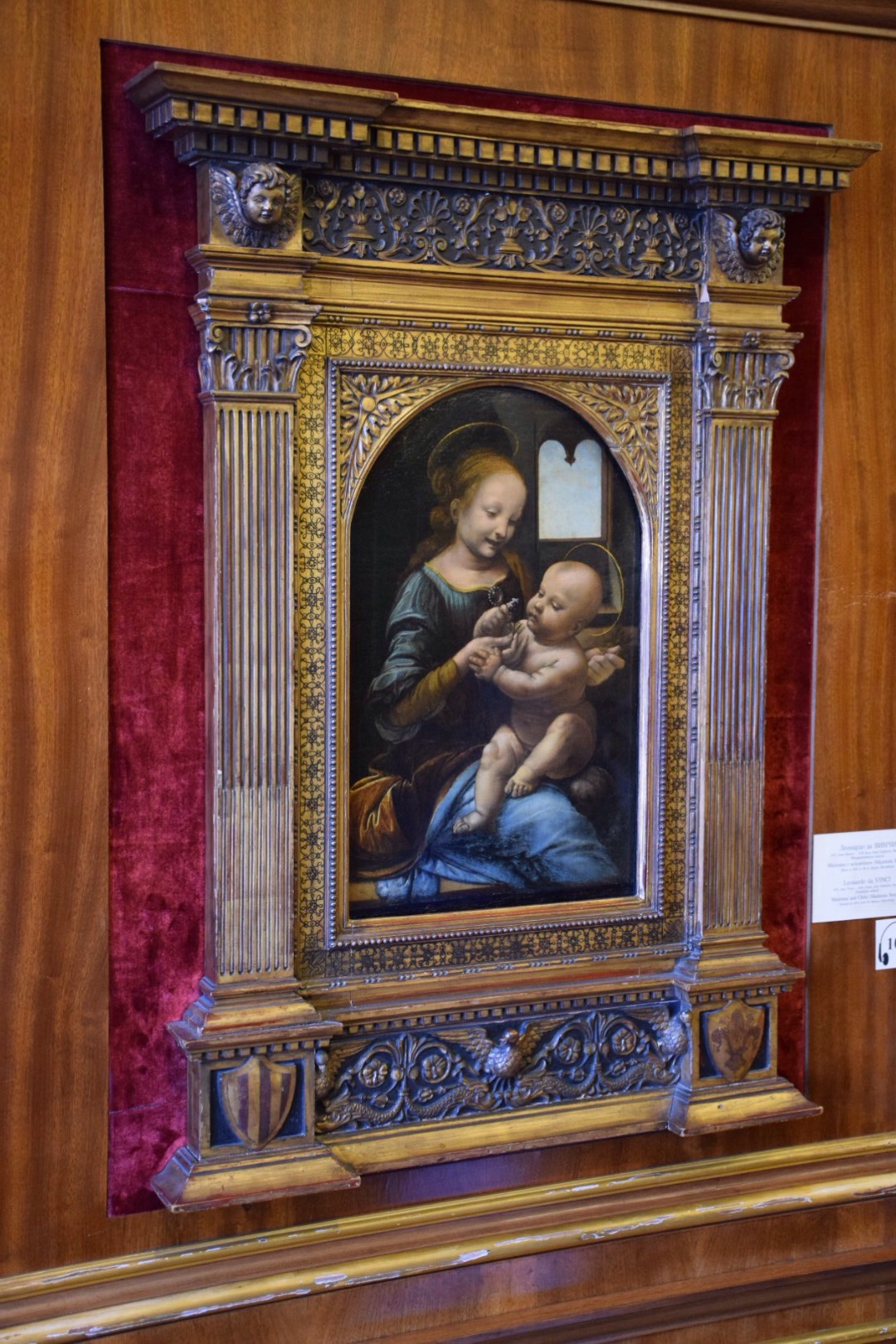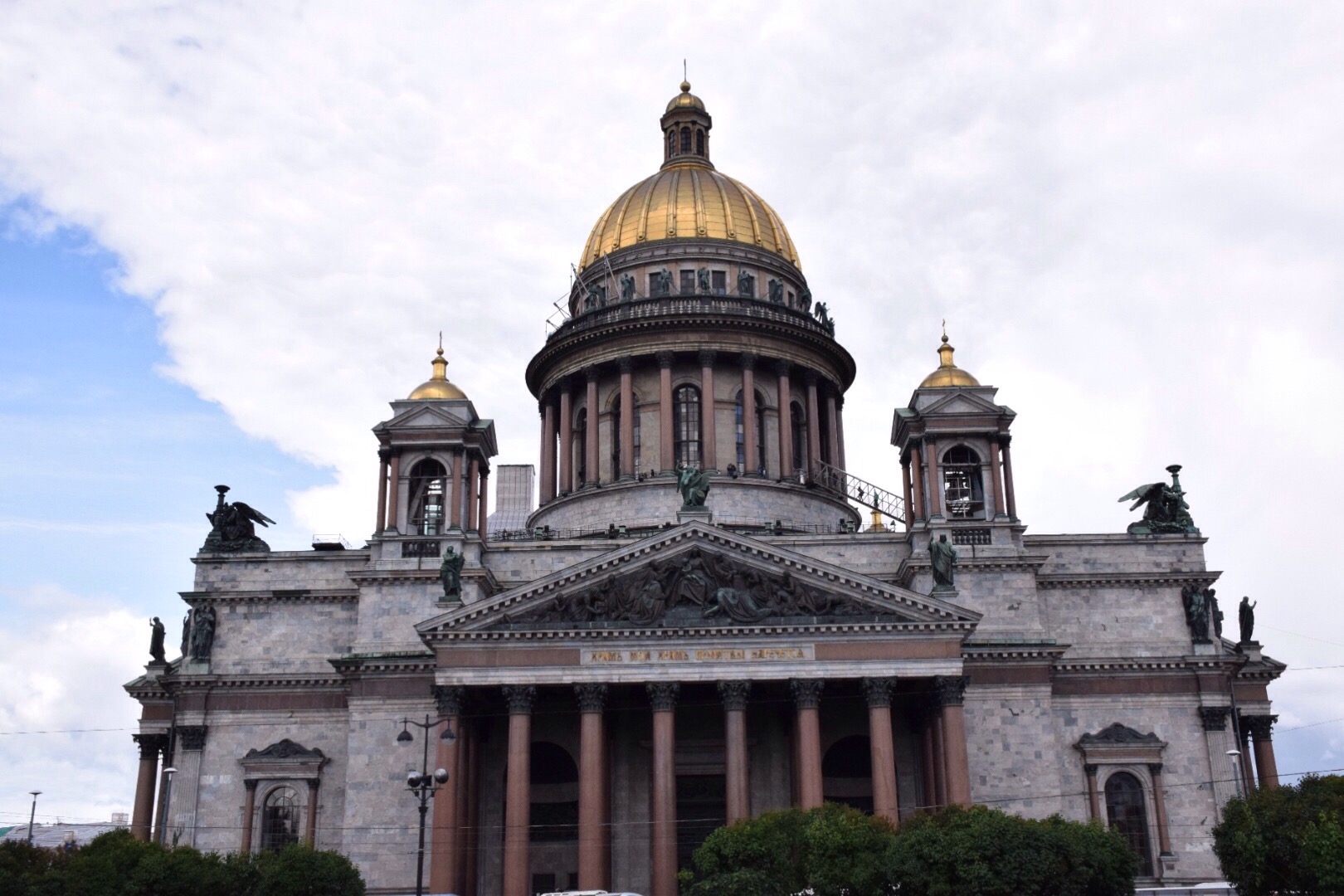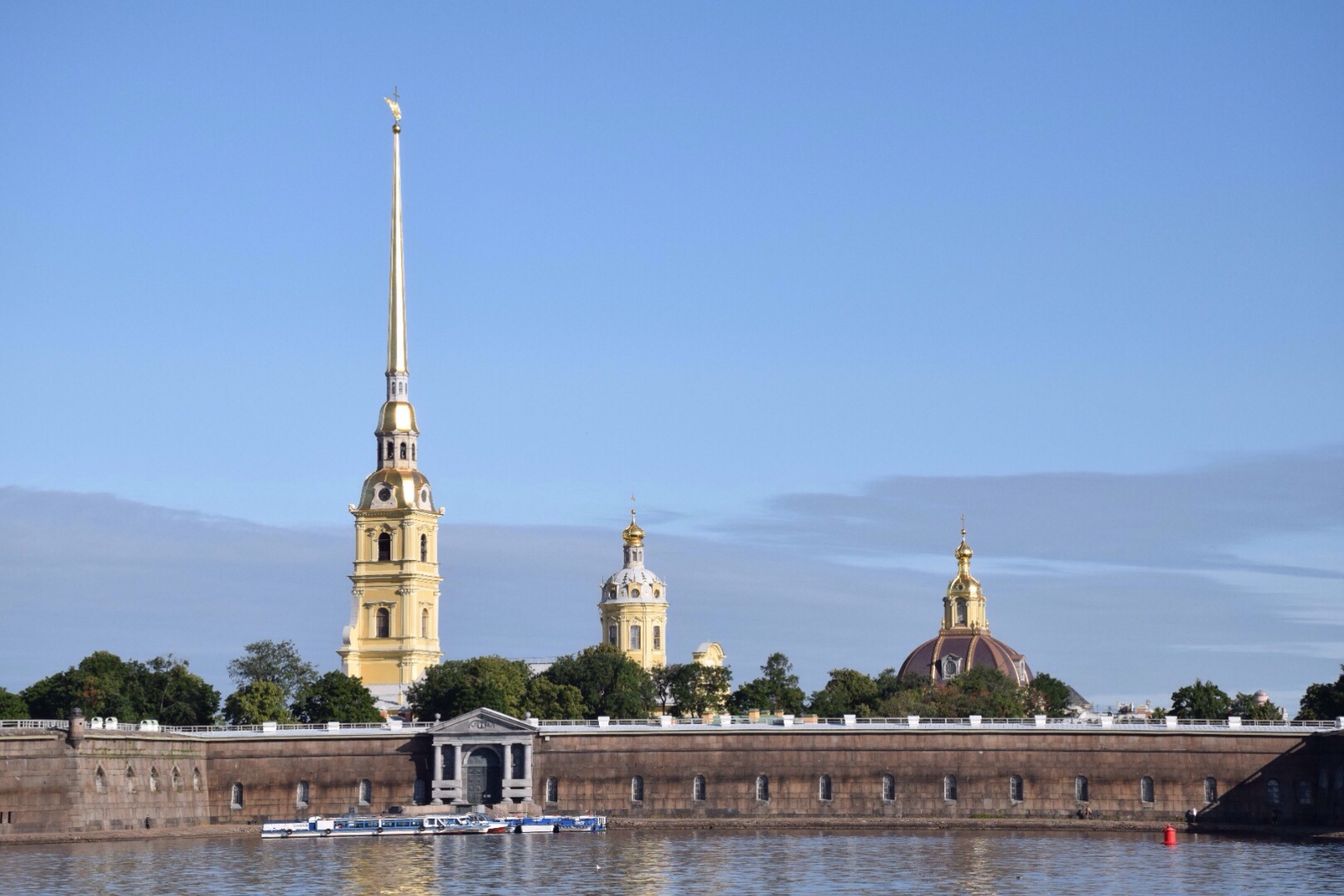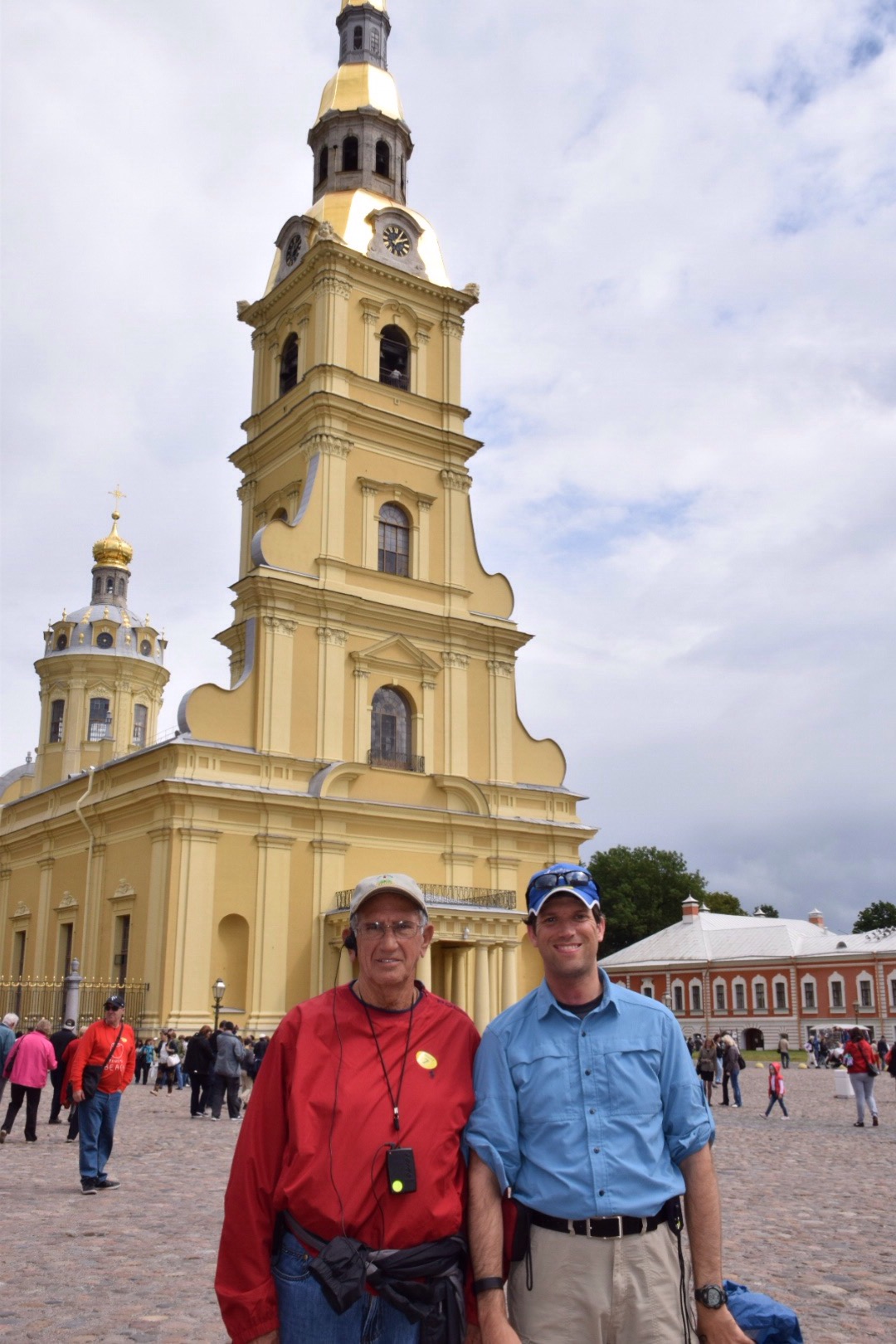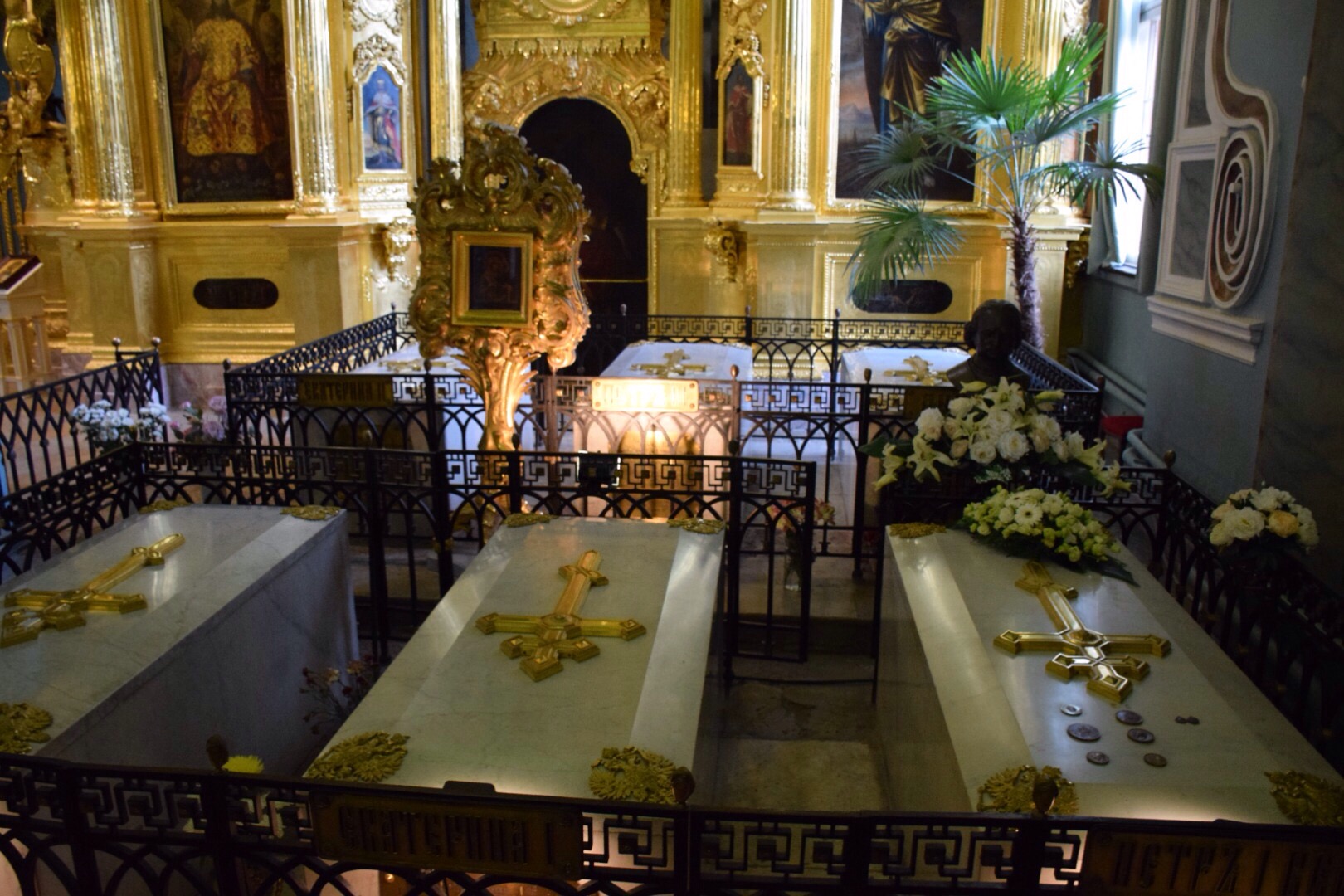We had an early morning in Saint-Petersburg, Russia. After breakfast at 5:30, Daddy and I joined up with Patsy and Ben in the Princess Theater. Upon leaving the ship we had to go through immigration, and I got a Russian stamp in my passport!!
We boarded a motor coach for the day 1 of the tour with our guide Konstantin, who is a native of St. Petersburg. Our first stop was Peterhof Palace, in the town of Peterhof, which was over an hour from the port.
Along the way we saw lots of interesting things, and I just couldn’t believe I was in Russia. I honostly never thought I would visit this country in my lifetime.
Konstantin told us about the city as we travelled. It was founded in 1703 by Peter the Great. The area was controlled by Sweden, which meant that Russia was landlocked. Peter wanted access to the Gulf of Finland and the Baltic Sea, and also wanted to move the capital from Moscow to a location closer to Europe. He ultimately won the land from Sweden in the Great Northern War, which lasted 21 years.
Peter began construction of the city during the war on May 6, 1703. At the conclusion of the war In 1712, Peter moved the capital of Russia from Moscow to Saint-Petersburg. This lasted until 1918 when the Soviets moved the capital back to Moscow.
Peter wanted the city to be the “Window into the Europe” and ordered that all buildings have a different facade. Few of the original buildings have survived.
Today Saint-Petersburg is the second largest city in Russia with 6 million people (Moscow has 14 million). The total population of Russia is 146 million.
The city has changed names several times. In 1914 it became Petrograd. In 1924 it was changed to Leningrad after the death of Lenin. It was changed back to Saint-Petersburg after the fall of the Soviet Union in 1991.
One thing I noticed was that even thought there is a lot that is beautiful, much of the city is run down and dirty. Definitely not as clean and well maintained as the European cities we’ve visited to this point. We also noticed a lot of dormant construction, presumably because of economic problems.
After a while we arrived at the town of Pererhof and Peterhof Palace. This was a countryside residence of Peter the Great, and one of 10 palaces he built in the suburbs of Saint-Petersburg. It was originally built in 1715 (this year is the 300th anniversary), but this original structure was only a small part of the current building. The first expansion began in 1728, and in 1745, Baroque architecture was introduced to the palace.
The palace was captured by the Germans in World War II, and much of the structure was destroyed. The walls and floors have been rebuilt since this destruction.
The name “Peterhof” is German for Peter’s court. We started off touring the garden in front of the massive yellow white, and gold palace before entering the structure. Inside we were not allowed to take pictures, but it was the most ornately decorated place I’ve ever seen, with many things covered in gold. The tour inside was fascinating as we saw dining rooms, ballrooms, dressing rooms, etc.
We exited the palace to the back garden and could see the Great Cascade Fountain with the gold statue of Samson and the lion.
We came outside around 10:15am and the fountains were not turned on until 11:00am.
While waiting for the fountains, we walked around the gardens, saw lots of gold statues, and admired the beautiful palace with gold “onion” cupola.
The fountains were started behind the palace with very dramatic music and fanfare. It was not quite as “Grand” as I was expecting, but was still quite impressive.
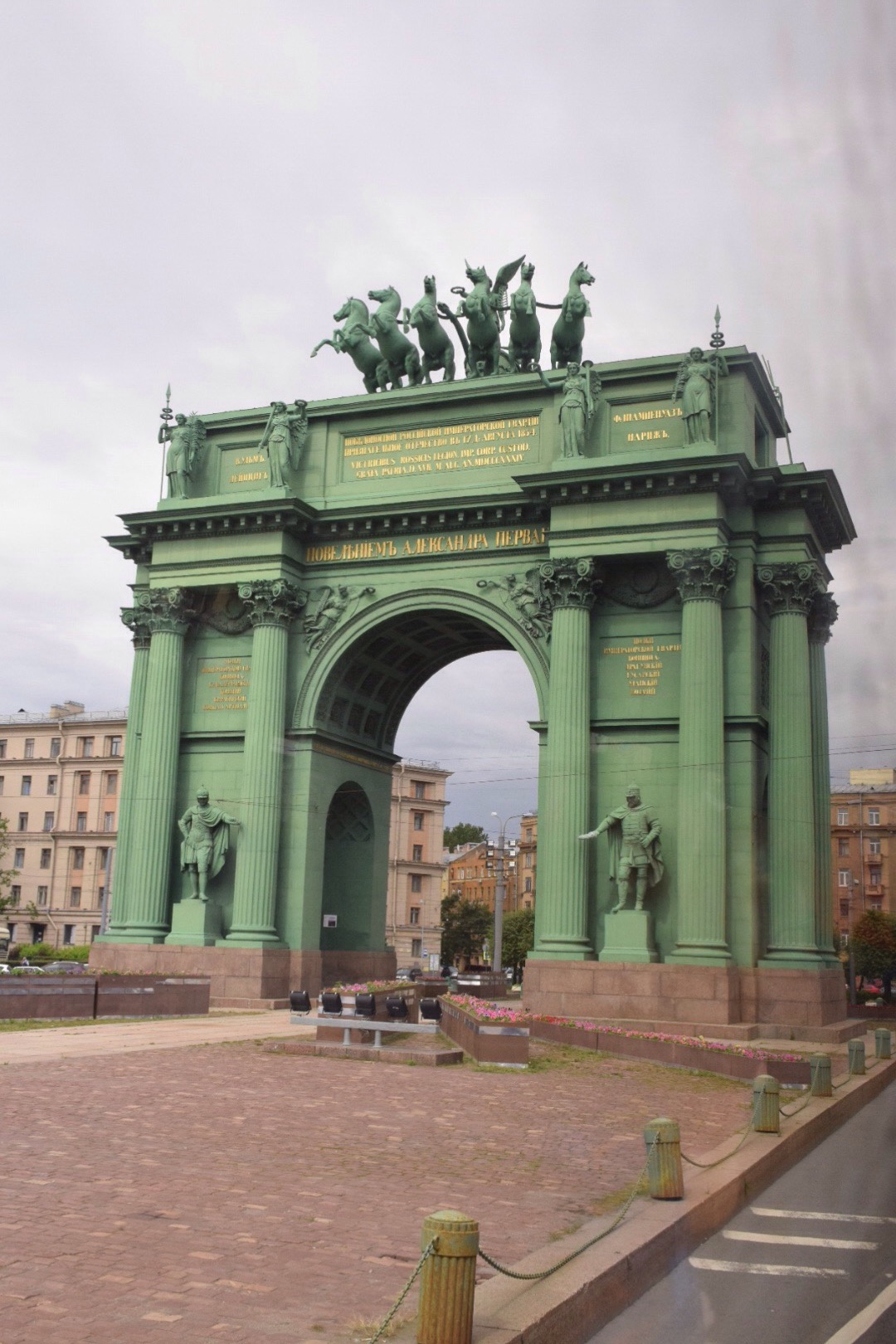
We then boarded the bus and headed back to Saint-Petersburg. On way back from Peterhof saw one of the residences of the Russian President. We also saw the Triumphant Arch, which commemorates the Russian victory over Napoleon.
Our next stop was Yuposob Palace. The Yuposob family was the 5th wealthiest in Russia. They owned 300 factories and had 3 palaces in Moscow and 3 palaces in Saint-Petersburg. They were Involved in the assassination of the peasant, healer, holy man, fortune teller named Rasputin. The story is very long, but they tried to poison him, and it didn’t work. When they saw that it didn’t work, they shot him twice. However his cause of death was determined to be drowning.
We toured their massive palace and even saw wax figures created to represent the assassination of Rasputin. The inside of the palace was also very ornate. The most interesting thing to me was a “vaulted” ceiling that was actually flat, but painted in such a way that it was really hard to tell that it wasn’t vaulted.
After the Yuposob palace we went to Nicholav Palace for a traditional Russian lunch. We had Russian Salad, caviar, mushroom soup, and beef stroganoff. It was quite good and very hardy. I sat next to a lovely couple from Melbourne, Australia and had a wonderful conversation.
With dessert they served Russian coffee and I ended up drinking three cups, because Ben and another lady did not want theirs. It was super strong and awesome.
Next came St. Isaacs Cathedral. It was built in 1712, and has the first metal cupola constructed in Russia. The cupola contains 100 kilos of pure gold, and 60 men died of mercury poisoning during the construction.
It is a Russian Orthodox cathedral, which is the official religion of Russia. 65% of the population of Russia claim to be Russian Orthodox, but this is more related to cultural ties than religion. There are only 9 million active Christians in Russia and 4 to 5 million Muslims.
In 1920 the Soviets turned the cathedral into a center for atheism, and it was used for the spreading of atheist propaganda. The cathedral was spared destruction during World War II, because it provided a good guiding point for German planes. The Russians painted the gold dome gray to try to hide it, but this was not the reason it survived.
The inside of this cathedral was overwhelming with its ornate mosaics, doors, altars, and windows. It almost seemed like the inside was all made of gold. The doors to the cathedral are made of ornately carved wood, covered with bronze, and weigh 10 tons each.
In the center of the cupola is a winged representation of the Holy Spirit. From the ground this appears to be tiny, but the structure is so massive that it is actually 9 feet across.
Our final stop for the day was the Church of the Resurrection of Christ. It is also known as the Church of the Spilled Blood because it was built at the location where Alexander II was mortally wounded.
This was probably the highlight of the day for me even though it started to rain as we got out of the bus. The outside of this building was phenomenally beautiful with its multicolored “onion” cupola. The inside of the church building was almost completely covered in mosaics that were simply stunning.
We travelled back to the port around 4:30pm and then had 1 hour to eat and change clothes before heading back to the motor coach for a trip to Catherine’s Palace. The palace is about an hour and a half outside of Saint-Petersburg, and this allowed our guide Irina to give us lots of information about the palace.
It was originally built by Peter the Great as a gift to his wife Catherine the First. It also happened to be the favorite palace of Catherine the Great (II), though it was not named for her.
Peter the Great had 10 palaces in the suburbs of Saint-Petersburg, and this was the second palace he constructed after Pererhof. Catherine’s is one of the largest palaces in Russia. It is over a quarter of a mile in length and is covered in gold inside and out.
We also heard a lot about Catherine the Great. She was a German princess that married into the Russian royal family. She ruled Russia for 34 years and generally spent her summers in this palace.
Once we arrived at the palace we first toured the neighboring Carriage Museum. There were lots of old Russian made carriages used by the royal family in the museum. The most interesting to me was the carriage Alexander II was riding in when he was asasinated by a bomb. This was very relevant for the day since the Church of the Spilled Blood was built on the site where this occurred. As we came out of the museum it started to rain pretty hard.
Before entering the palace, they had a vodka and caviar reception in one of the outer buildings. I abstained from the vodka but really enjoyed the red caviar.
After the reception we could finally see the full length of the palace and it is beautiful and ridiculously enormous. Even from a long way away, there was no chance of fitting it into a single photo (without panorama). We entered the palace at the ground level and then headed upstairs for the tour.
The palace is essentially made up of two rows of rectangular rooms from front to back. We started on one side and toured all the rooms and the turned around and toured the other side. The rooms were very ornate, and many were covered in gold. One of the most stunning was the Amber Room that was covered from floor to ceiling with Baltic Amber.
Once we reach the end ballroom, we enjoyed a short musical performance followed by a skit and dance by actors in period costumes. Back outside the performance continued with a band and more actors that came into the square on a horse-drawn carriage.
We then boarded the motor coach for our ride back to the ship. I got to talk to my girls for a few minutes on the way, and it was great to hear their voices.
We arrived back at the ship around 11:30pm and had to be back at the terminal by 6:30am for day 2 of our tour.
Day 2 started with a boat ride through several major rivers and canals within the city. These canals were necessary in the building of Saint-Petersburg, because it was built on swamp, and the land needed to be drained. Also Peter the Great wanted the city to be the Venice of Russia. He didn’t want any bridges to be built and wanted all citizens to travel by boat. This proved impractical when the canals froze during the harsh winters.
The end result was 65 rivers and canals with over 300 bridges. The primary river through the city is the Neva.
Yesterday I wrote that the city appeared dirty from street level, but this was not true from the water. It looked magnificent. I thoroughly enjoyed touring the city by boat. I also found it interesting how low the bridges were, and how close came to many of them from the boat. Even from a seated position I could have easily touched the bottom of several bridges.
Next we went to Saint-Petersburg Square, which was quite impressive. On one side of this square is the Hermitage museum that is made up in part by the Winter Palace, which was the third palace built by Peter the Great. It contains 1000 rooms, but the original was destroyed by fire in 1837.
The Hermitage museum contains 2.8 million items, though not all are on display. For the displayed items, it would take 3 weeks to see them all if you only spent 1 second per item.
The museum was started in 1764, and the name means “dwelling of hermit.” We spent a couple of hours in the museum and our guide Konstantin did a great job of walking us through the highlights. By far my favorites were the the paintings by Rembrandt, Leonardo Da Vinci, and Raphael. The museum and Winter Palace we also quite stunning themselves.
Our last stop before lunch was at St. Isaacs Square to take pictures of St. Isaacs Cathedral that we visited yesterday.
We had lunch in a large, ornate banquet hall. This included red caviar on small pieces of bread. I ended up with three pieces because of others at the table who didn’t want theirs. This was the best caviar we had over our two days. During lunch we also enjoyed a traditional Russian folk show with music and dancing.
We had a few minutes for shopping and then headed to Peter and Paul Fortress. Inside the fortress is the Cathedral of Apostles Peter and Paul. It was built between 1712 and 1733 by Peter the Great.
Prior to Saint-Petersburg, Russian Czar’s were baptized and buried in Moscow at the Kremlin. Peter built this as a burial area for the royal family in Saint-Petersburg.
The fortress is surrounded by a wall with the cathedral inside. Inside the cathedral are the burial chambers for both Peter the Great and Catherine the Great. Every member of the Romanov family was buried there from Peter I through 1917 (Soviet revolution). It was really fascinating to see the tombs.
Outside the cathedral we could see the mint that is still in operation for creating rubles. We could also see the boat house for the fortress.
We headed back to the ship around 3:30pm, and I was able to talk to the girls briefly on the phone before dinner at 5:30pm. Dinner was Italian in the Concerto dining room, and I especially enjoyed the veal scaloppine.
The show was a ventriloquist who was not that great (especially after seeing Terry Fator earlier in the year). I then watched us sail through the Saint-Petersburg harbor toward Finland.

